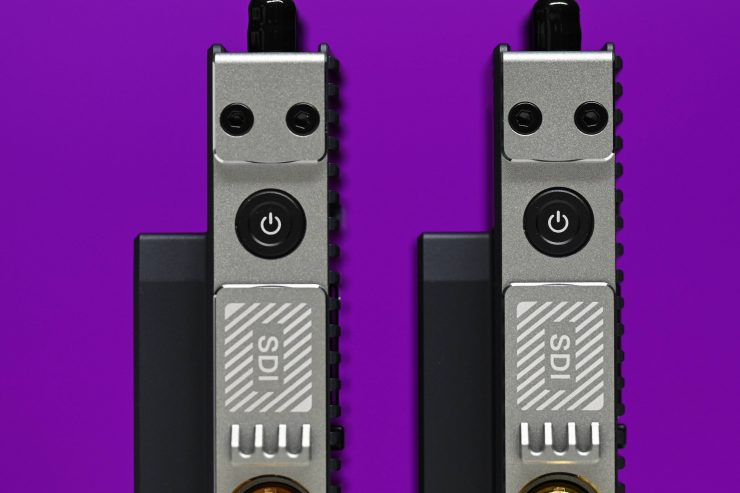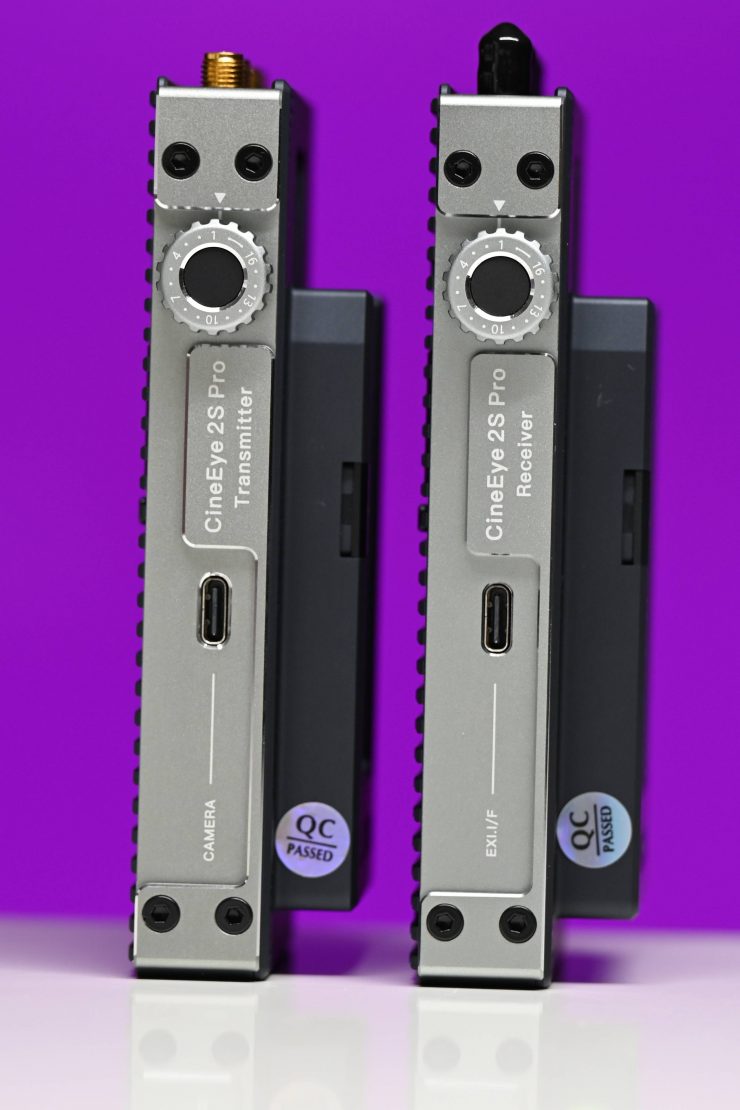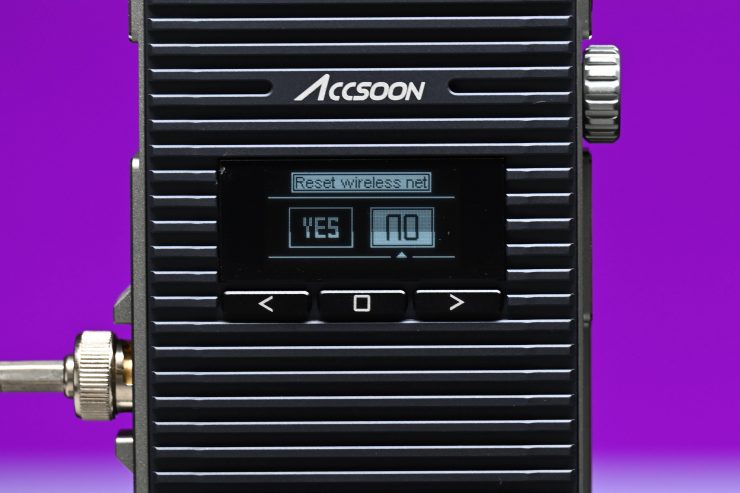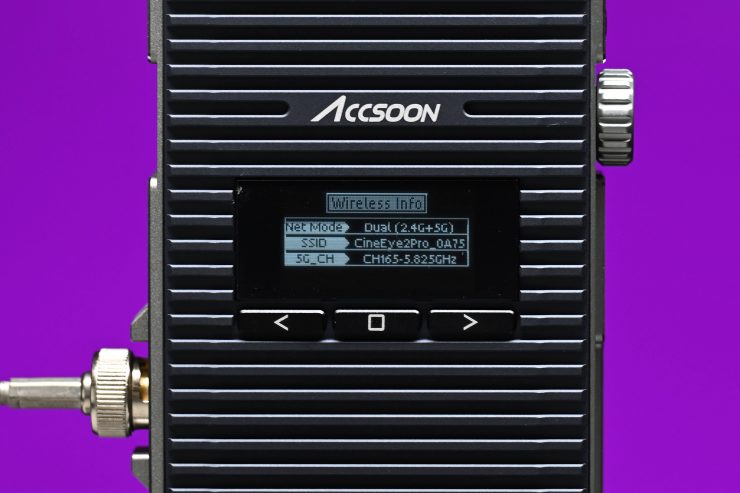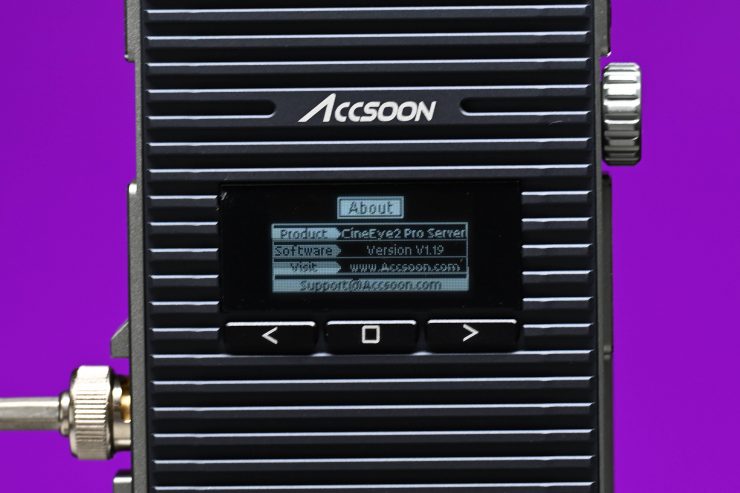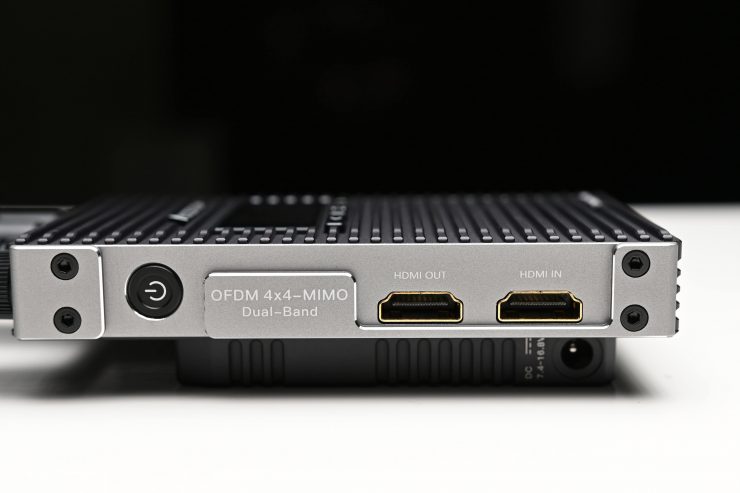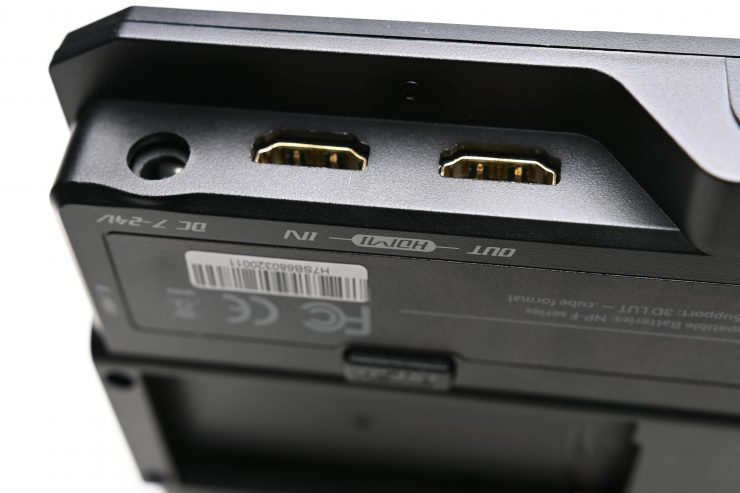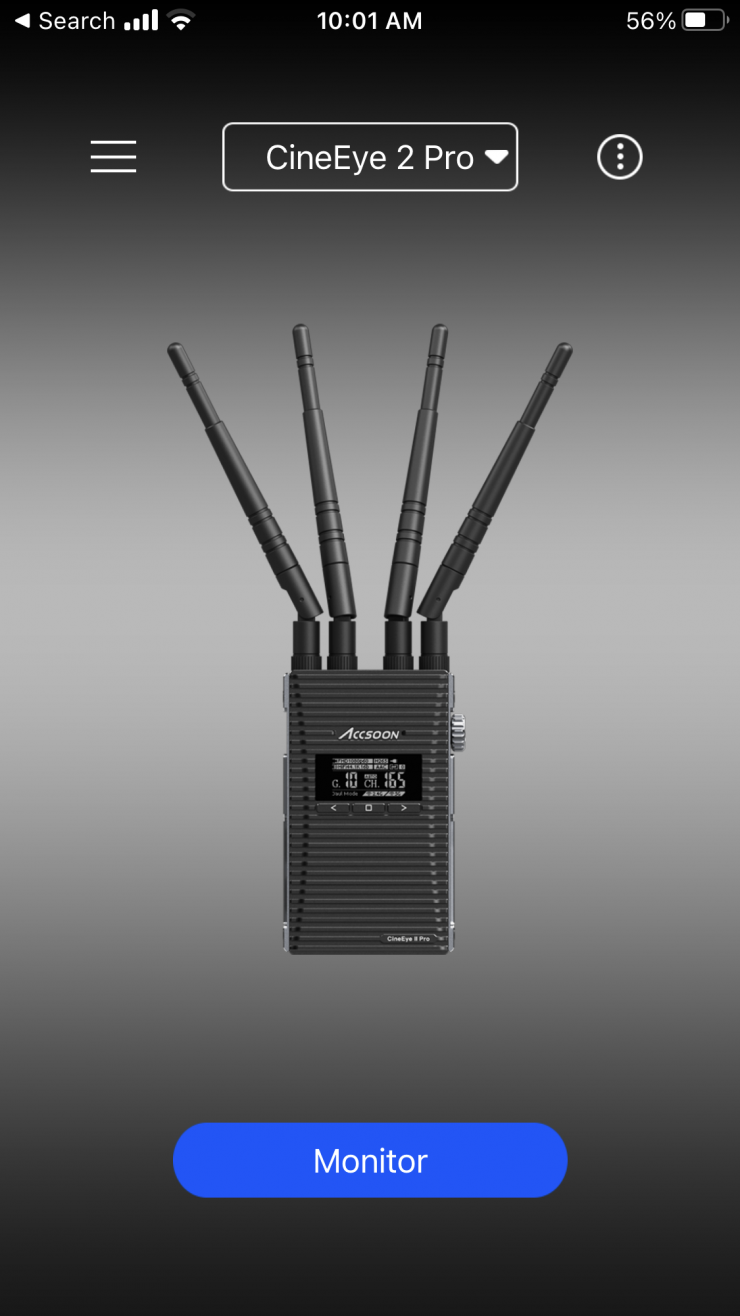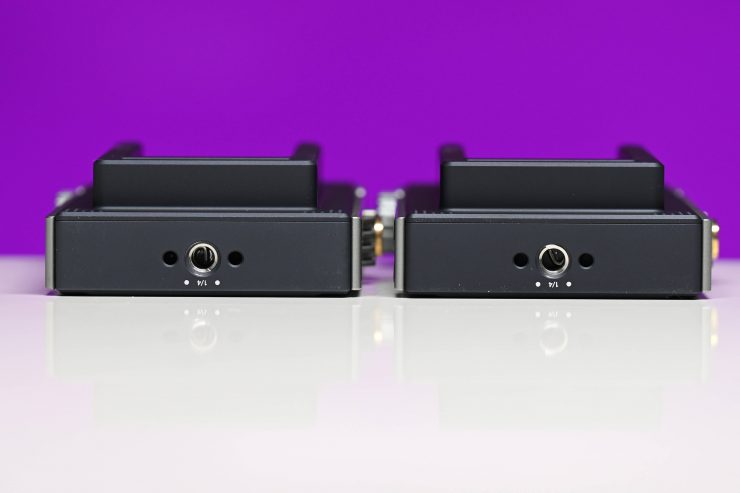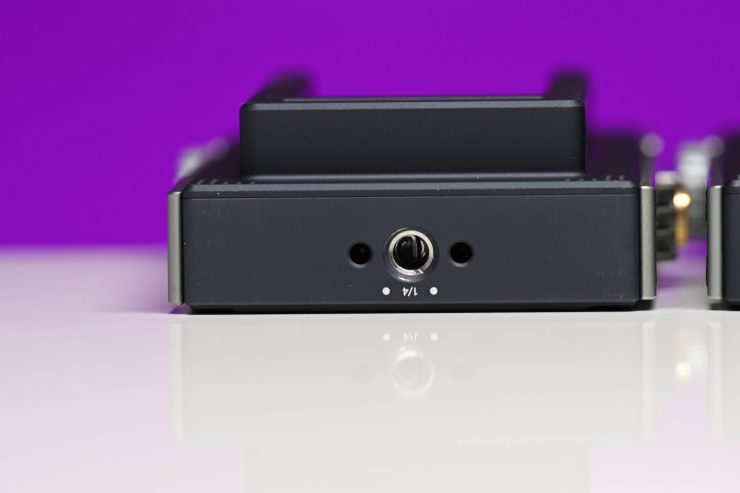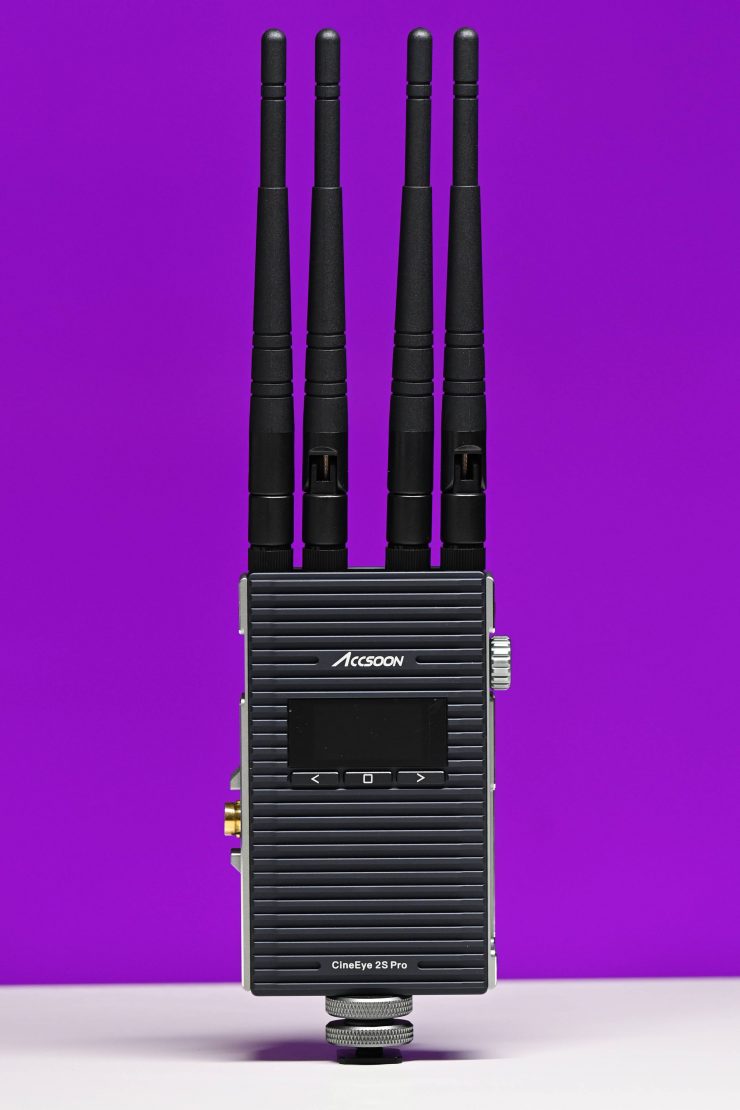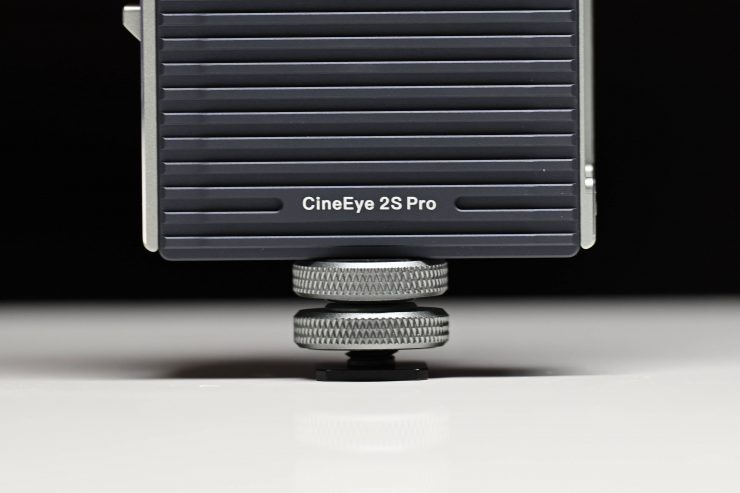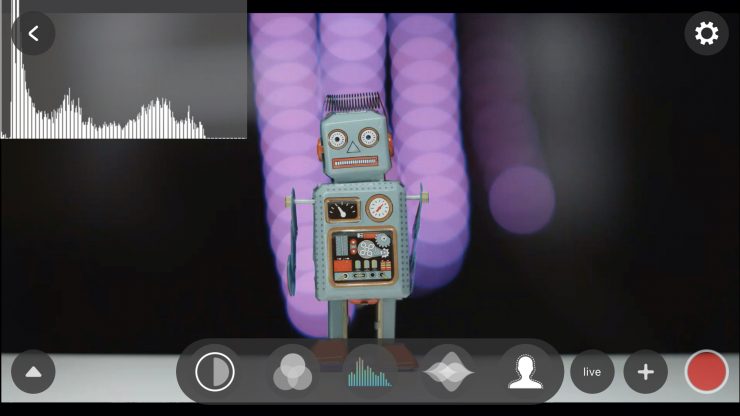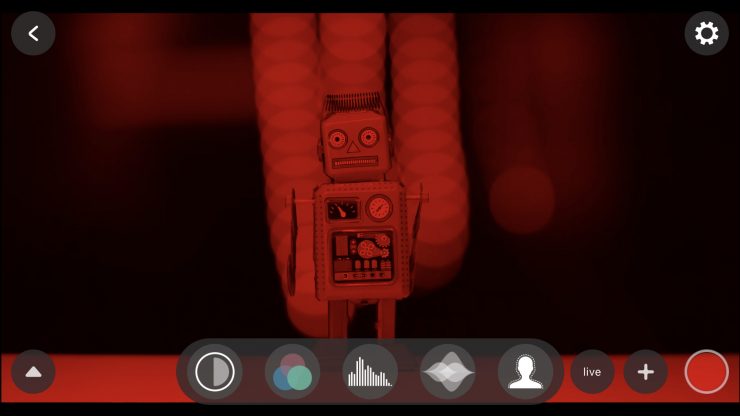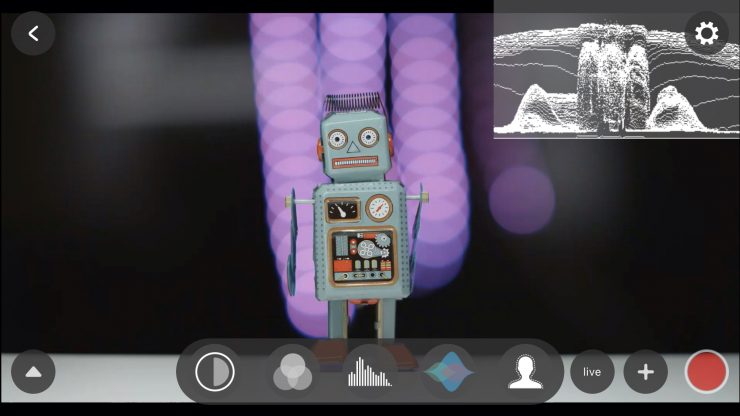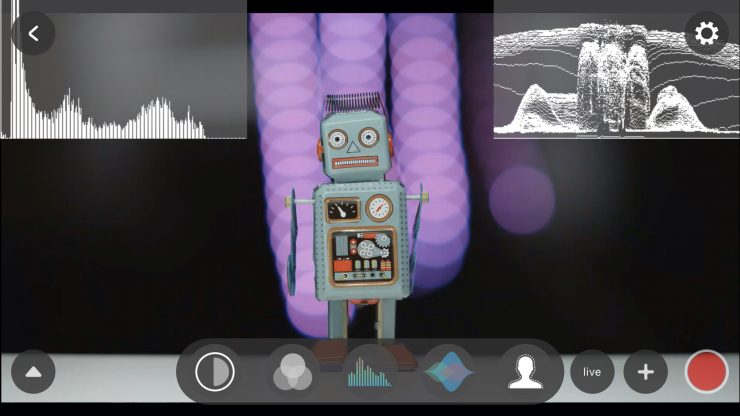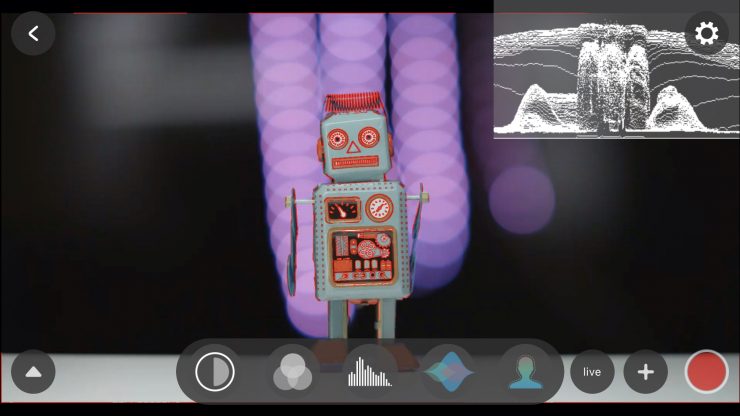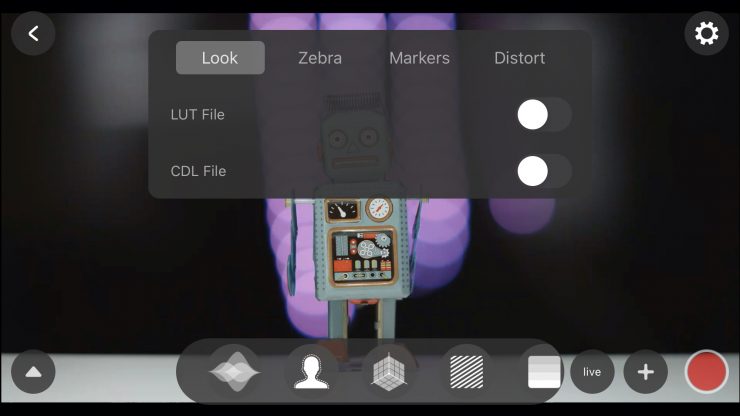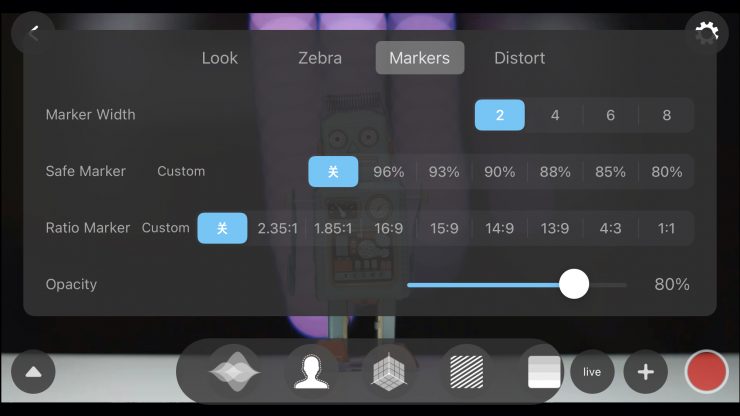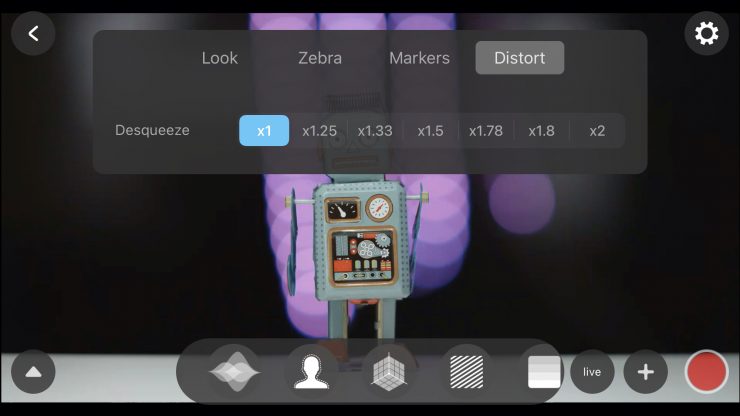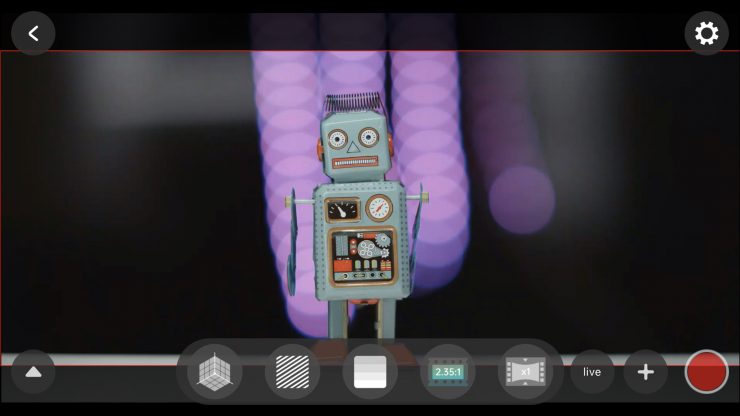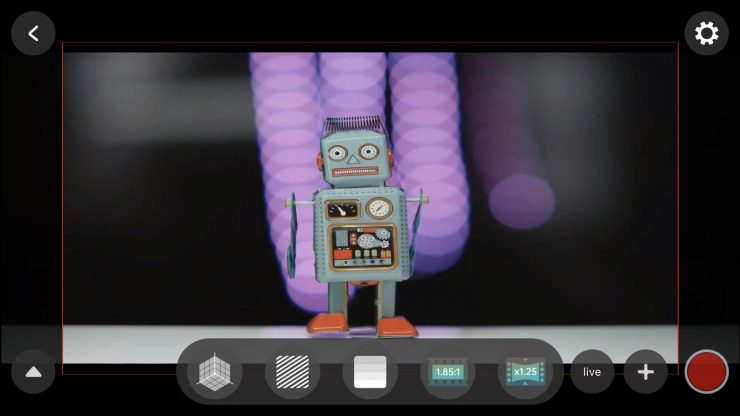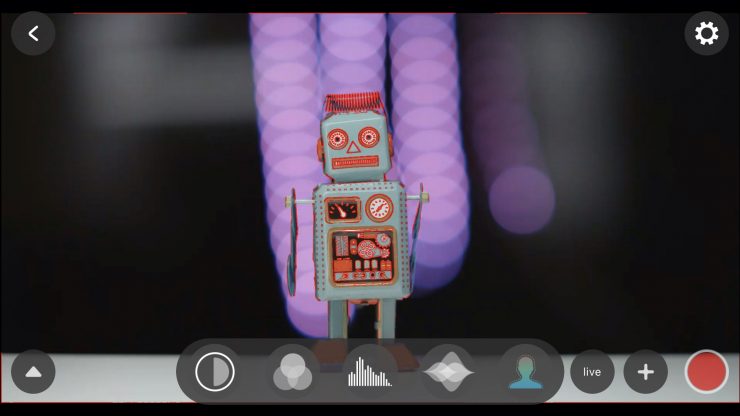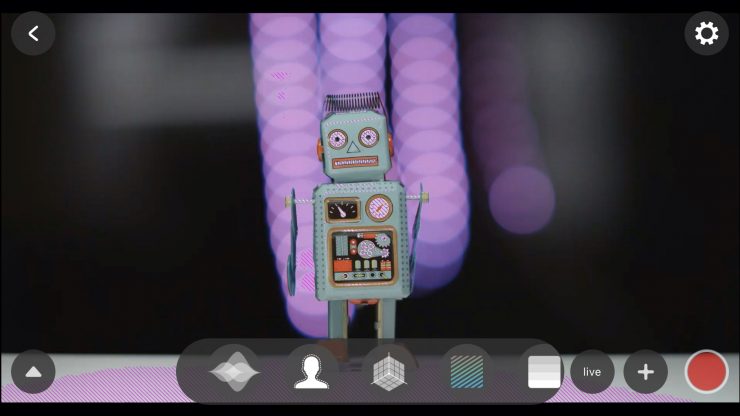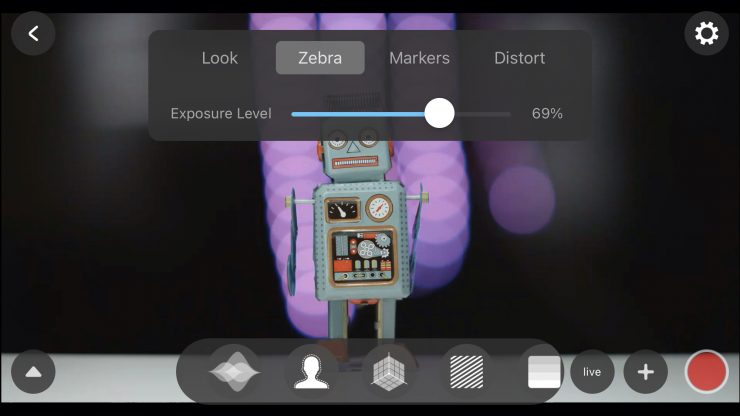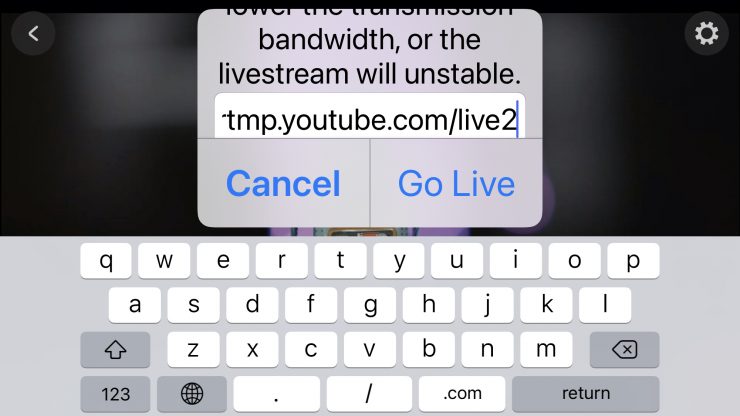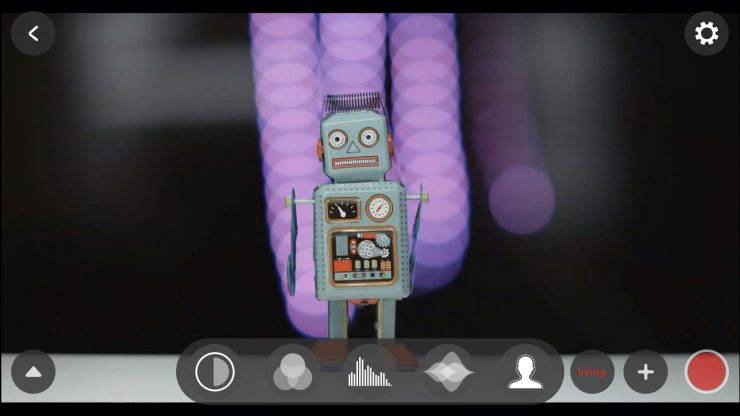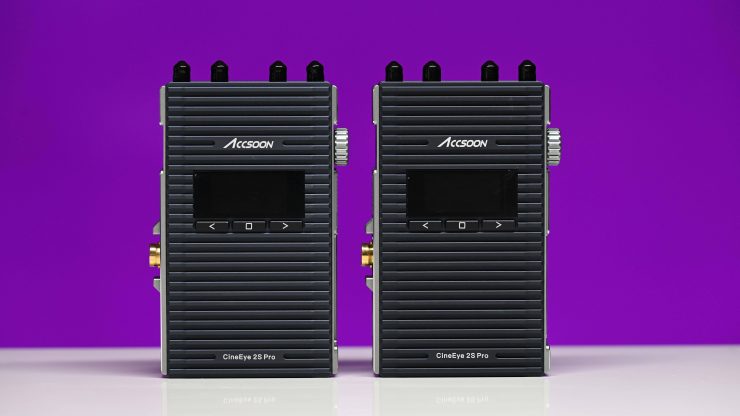
The Accsoon CineEye 2S Pro is a new addition to the CineEye line-up. The CineEye 2S Pro is essentially the same as the CineEye 2 Pro, but the ‘S‘ differentiates it as having SDI.
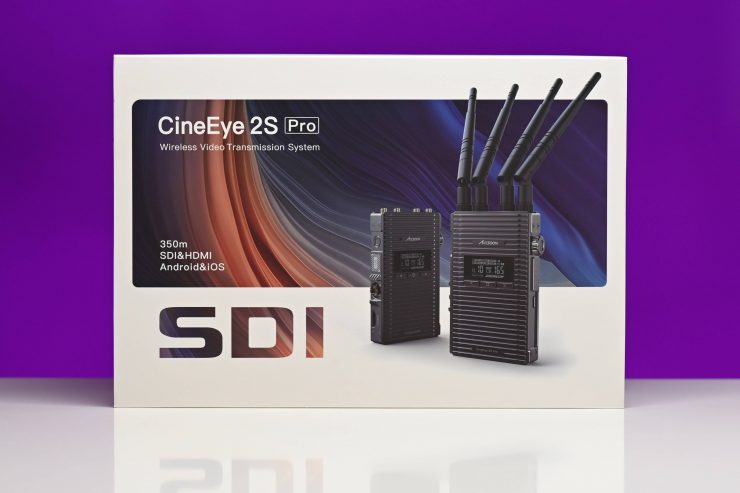
Accsoon has been very busy recently and they have bought a multitude of products to market since September that year. You can see my review of those products below.
- CineEye 2
- CineEye 2S
- CineEye 2 Pro
- CineEye 2S Pro
From small beginnings
The original CineEye was a big hit with budget filmmakers as it allowed you to stream an HDMI signal directly to smartphones and tablets through Wi-fi. At $199 USD it was arguably the first budget-friendly way of viewing wireless video on multiple devices. Above you can see our video report from NAB 2019.
So let’s check out the CineEye 2S Pro.
Key features
- High-reliability dual-band (2.4G and 5G) transmission
- Transmission range of up to 1200 feet
- Very low latency ( <0.06 seconds)
- TX SDI In & HDMI In
- RX SDI Out & HDMI Out
- High-quality audio transmission
- Supports transmission to up to 4 receivers ( standalone receiver and mobile devices, mix and match )
- Camera Control supported
- Professional monitoring App for iOS and Android
- 1.3 inch OLED display
- DC and battery power supply supported
- Firmware upgradable
Size & Design
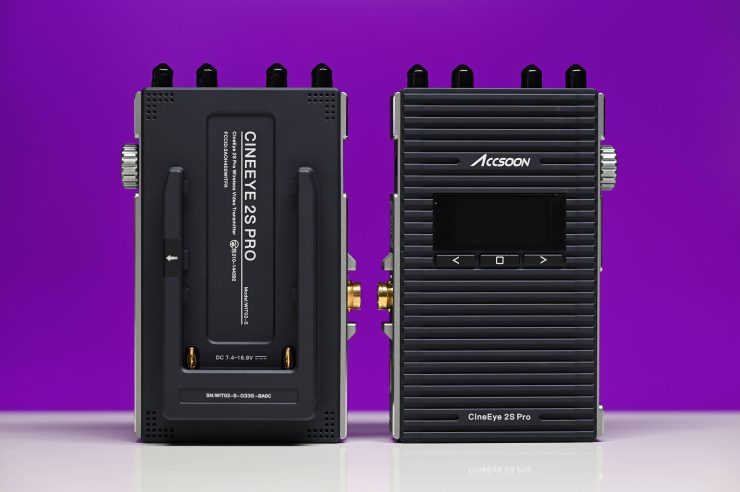
The CineEye 2S Pro is quite large and it more closely resembles a traditional wireless video transmission system, than a Wi-fi based system.
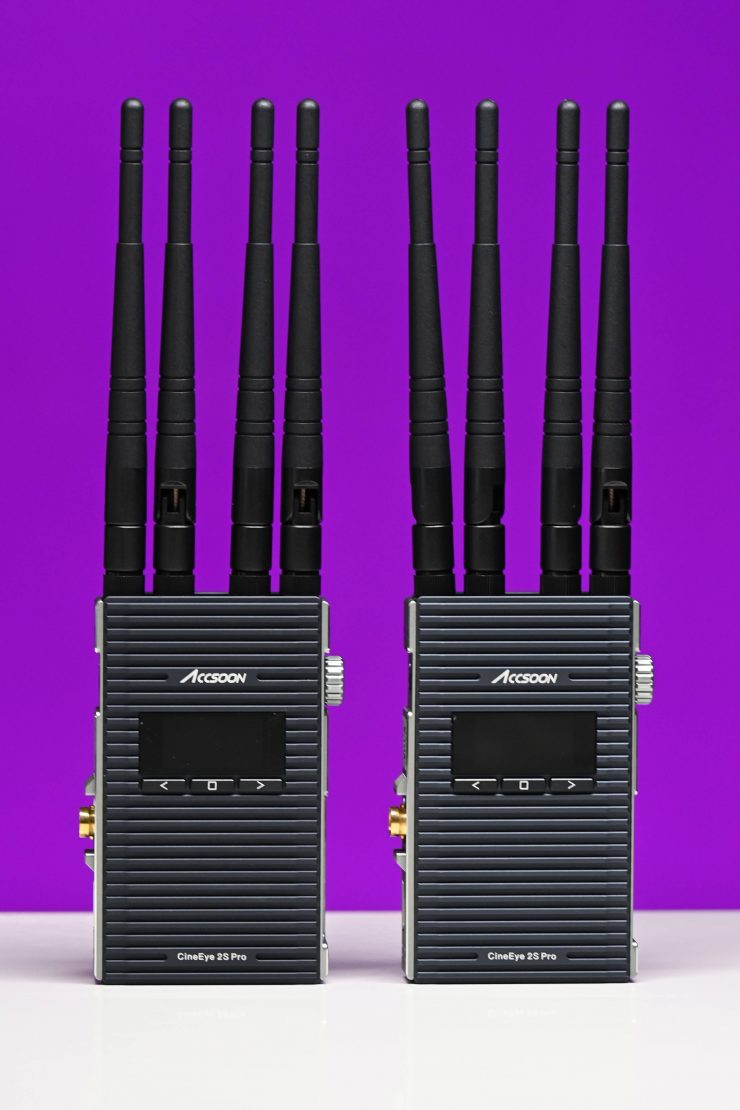
Instead of there just being a transmitter, the CineEye 2S Pro consists of both a transmitter and a receiver. This way you can use the system to either transmit to iOS or Android devices or/and to the receiver unit.
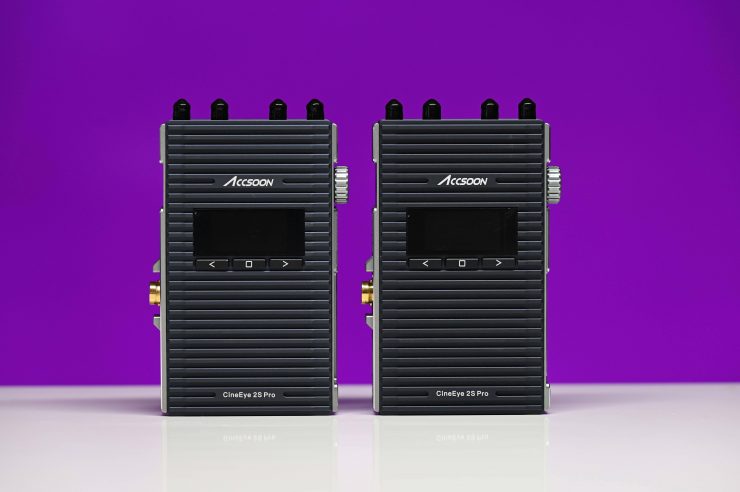
Despite the relatively large size, the transmitter and receiver both weigh 7.9 oz / 225 g. They also have the exact same physical dimensions of 4.92 x 3.03 x 1.22″ / 12.5 x 7.7 x 3.1 cm.
The design of the system is clean and modern.
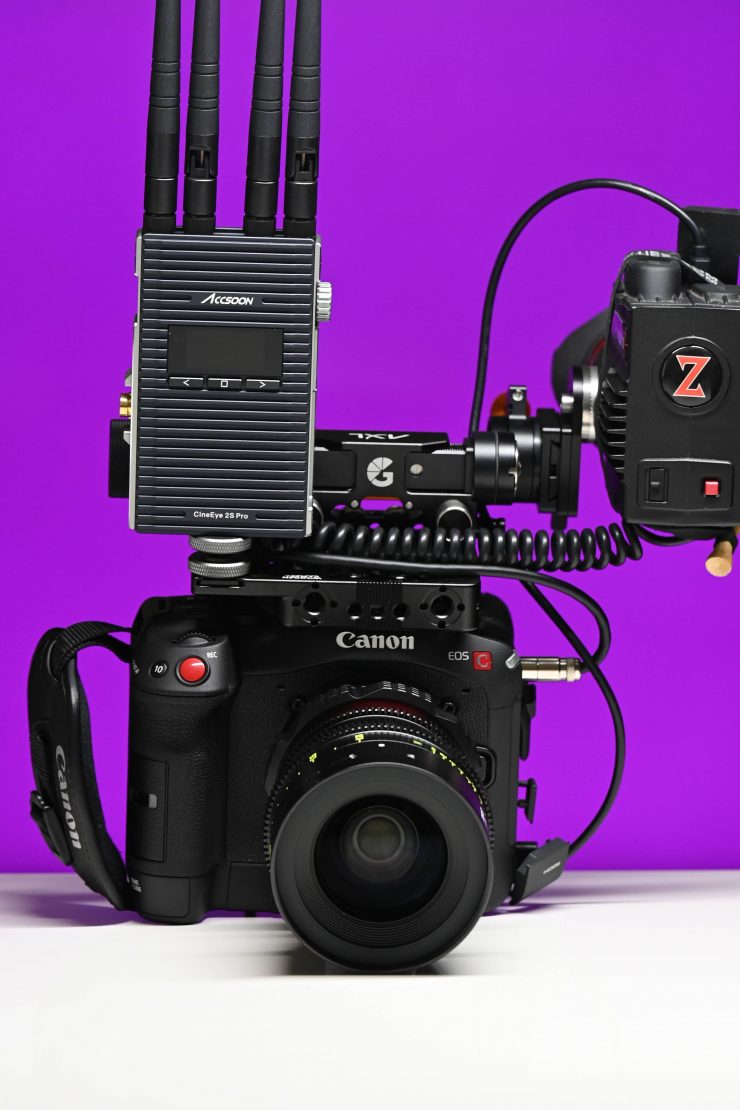
I personally think that the CineEye 2S Pro is too big if you plan on using it on a DSLR or mirrorless camera. Even on a small to mid-sized digital cinema camera, it will still occupy quite a lot of real estate.
This really is a product that is better suited for use on larger-sized cameras.
Concept
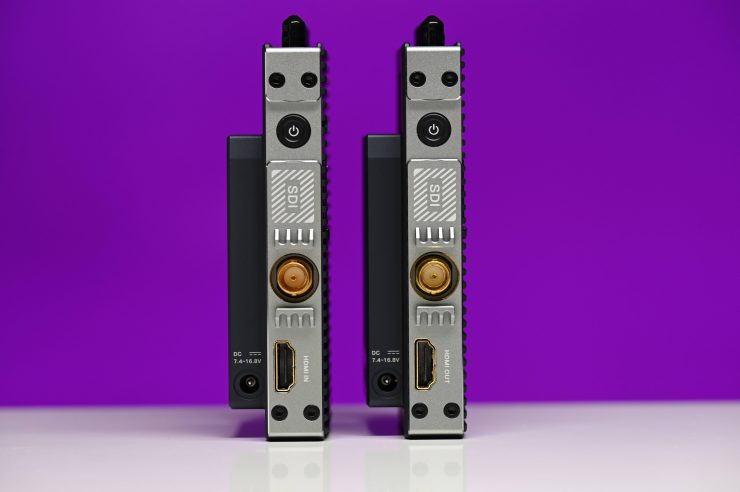
The CineEye 2S Pro, just like the CineEyes 2 Pro has placed Accsoon into a new segment of the market. Affordable SDI and/or HDMI wireless video systems have been popping up everywhere lately and it comes as no surprise that Accsoon wants a piece of that pie.
Unlike most of their previous products that were aimed primarily at the Prosumer, YouTube, Vlogger market, the CineEye 2S Pro is trying to attract a different kind of user.
The concept behind the CineEye 2S Pro is to give professional users a versatile, reliable, SDI and HDMI wireless video system that won’t break the bank.
Build Quality
The CineEye 2S Pro is robustly made and the overall build quality is better than most competing products in this price range.
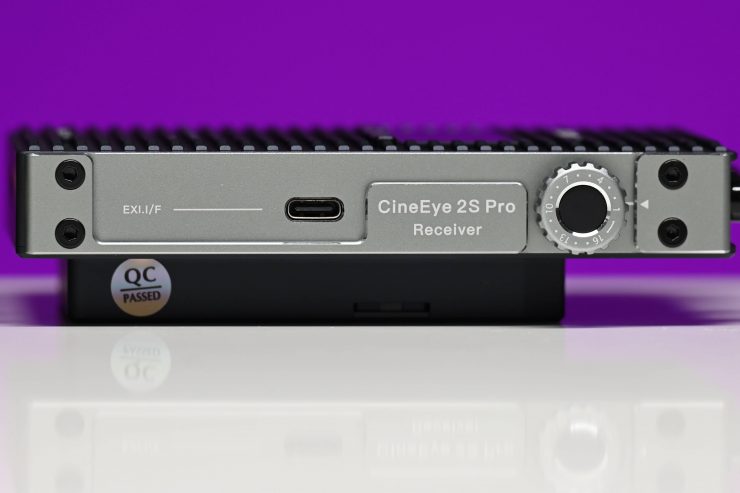
Both the transmitter and receiver are encased in a hard metal shell. The buttons and dials feel reasonably solid and there is nothing that I can see that concerns me.
What I did find is that both the TX and RX units do quite hot, especially once they have been on for a while.
What do you get?
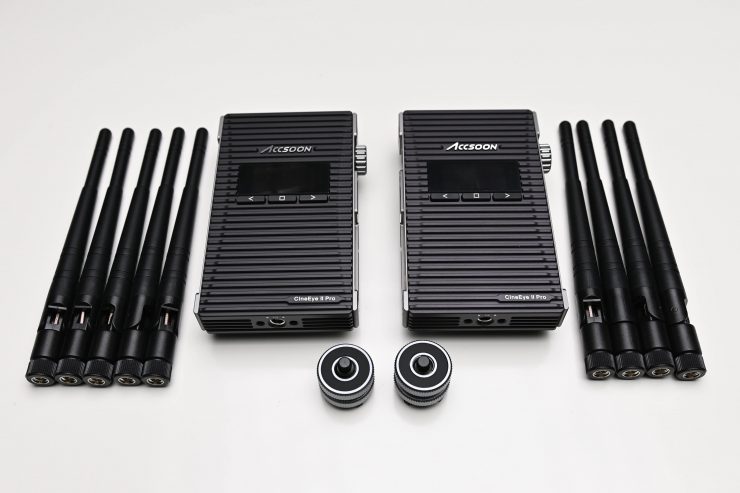
The CineEye 2S Pro comes with a TX unit, RX unit, user manual, 2x cold shoe mounts, and 9 antennas. You only need 8 antennas, but Accsoon gives you a spare.
Dual-Band Transmission
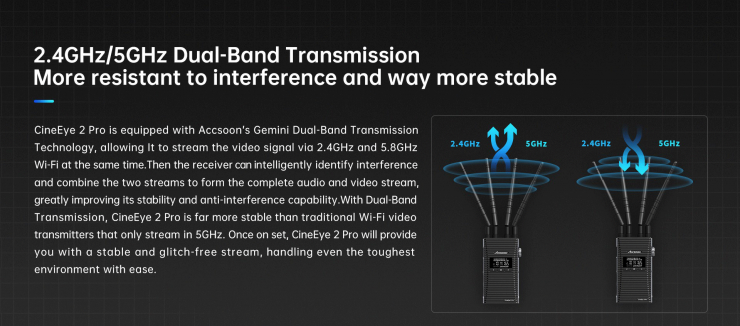
The CineEye 2S Pro utilizes dual-band transmission technology, which allows it to stream video via 2.4GHz and 5.8GHz Wi-Fi at the same time. The receiver can then intelligently identify interference and combine the two streams to form the complete audio and video stream. According to Accsoon, this greatly improves its stability and anti-interference capabilities.
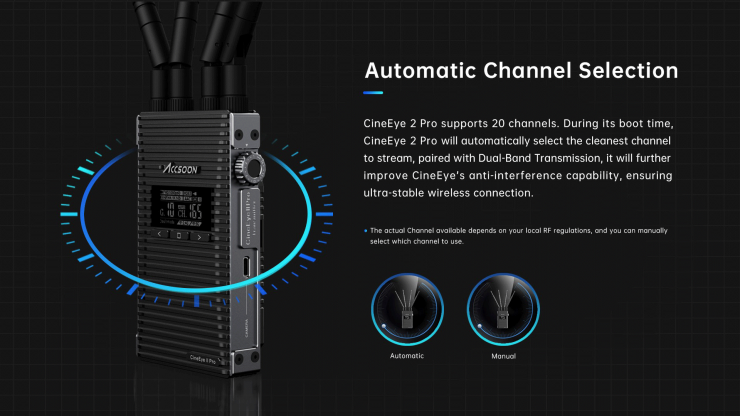
The CineEye 2S Pro also features automatic channel selection. There are 20 channels to choose from and the transmitter will automatically scan the area and find the least congested channel to transmit on.
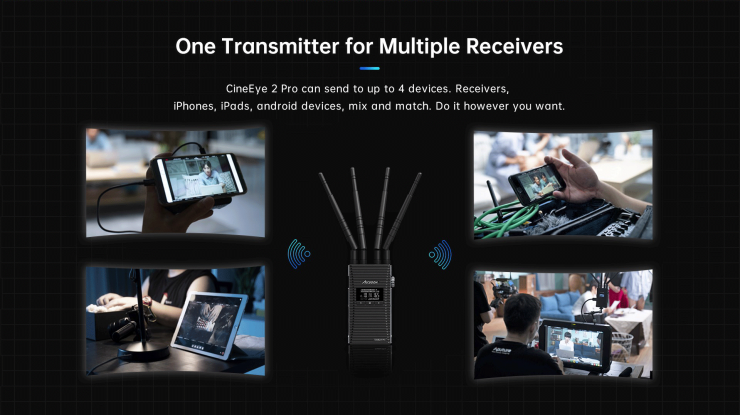
One transmitter can stream to up to four iOS or Android devices. You can use a combination of Android or iOS devices, as long as you aren’t using any more than four. The original CineEye was also capable of streaming to four devices at once.
You can also transmit to three iOS or Android devices as well as to the RX unit at the same time. One TX unit can also transmit to four separate RX units simultaneously.
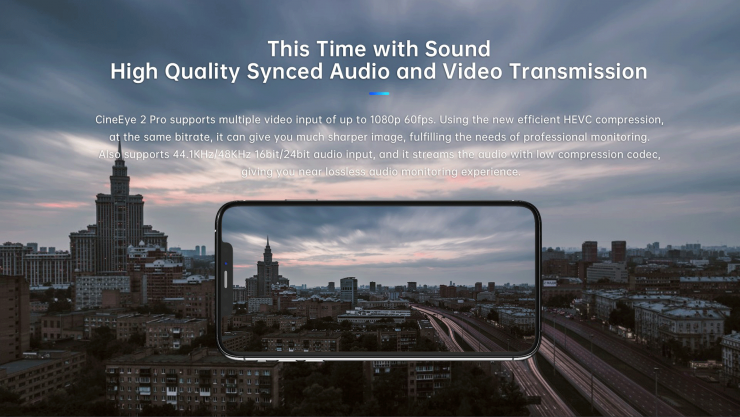
Unlike the CineEye 2 Pro that uses HEVC compression, the CineEyes 2S Pro utilizes the AVC codec rather than HEVC, because many mobile devices can’t support HEVC.
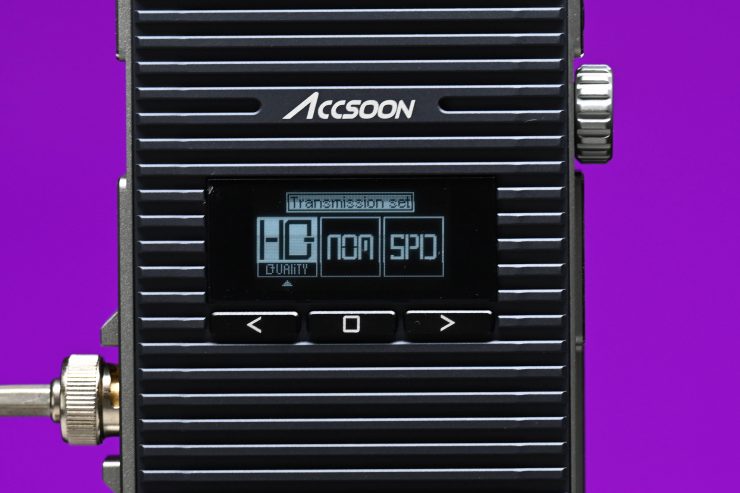
There is a Data Rate Setting that you can adjust on the TX unit. There are three different modes you can choose from:
- High-Quality Mode
- Normal Mode (default setting)
- Speed Mode
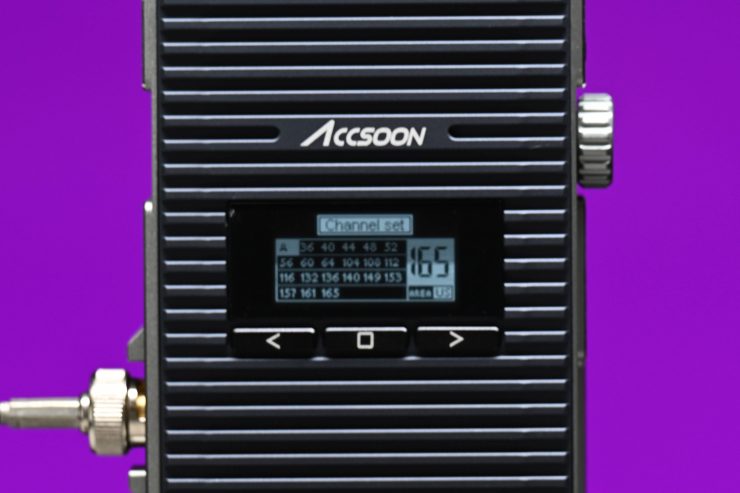
You can select from a range of different operating channels or just set the TX unit to Automatic channel selection.
Extended Range
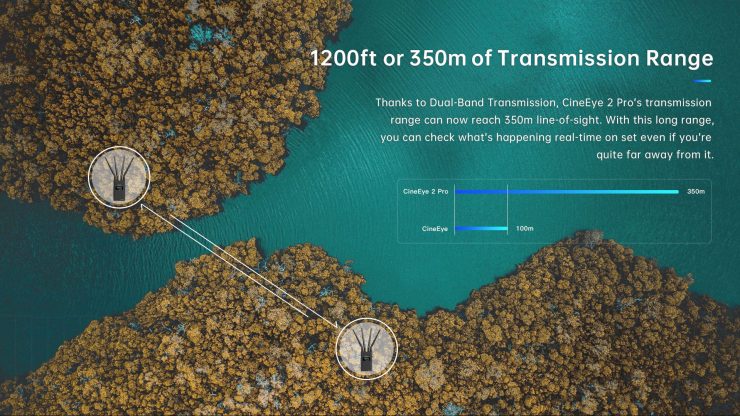
The CineEye 2S Pro has a claimed range of up to up to 1200 feet (365m), which is true, is an impressive range for a Wi-Fi-based system.
Accsoon claims that the latency on the CineEye 2S Pro is <0.06 seconds (60ms). In reality, this latency is usually a lot higher than 60ms and you also need to factor in the HDMI delay from the camera you are using. Some cameras have worse latency than others. Even when using SDI you are still going to get some latency.
I will test both of these facets of the system further down in the review.
Operating Interface
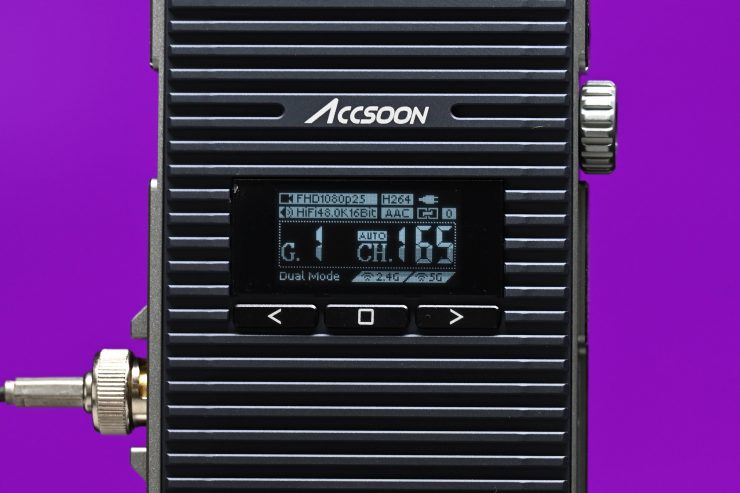
The screen on both the TX and RX units is nice and big and it lets you see key information clearly.
The boot-up time is reasonably slow for this device. It takes around 20 seconds from the time you turn on the TX unit until it comes up on the main screen.
The menu system is very easy to navigate and making changes is straightforward.
SDI & HDMI
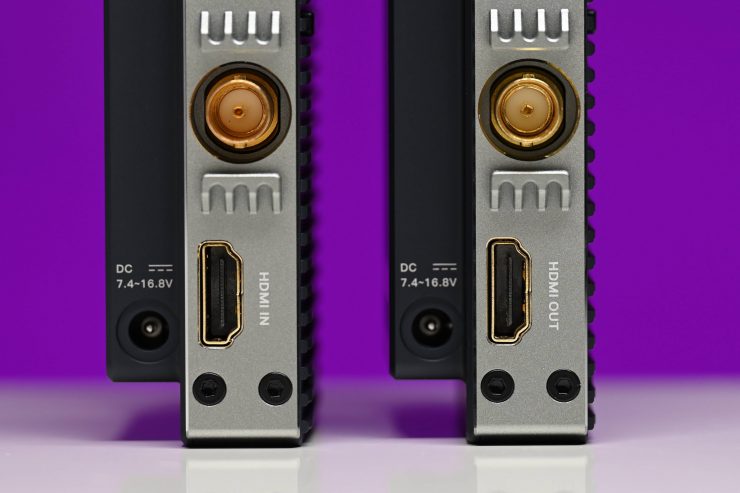
The CineEye 2S Pro has the ability to input either HDMI or SDI signals. This makes it very versatile and allows it to be used on just about any camera.
This is different from the CineEye 2 Pro which has an HDMI input and an HDMI output on both the TX and RX units.
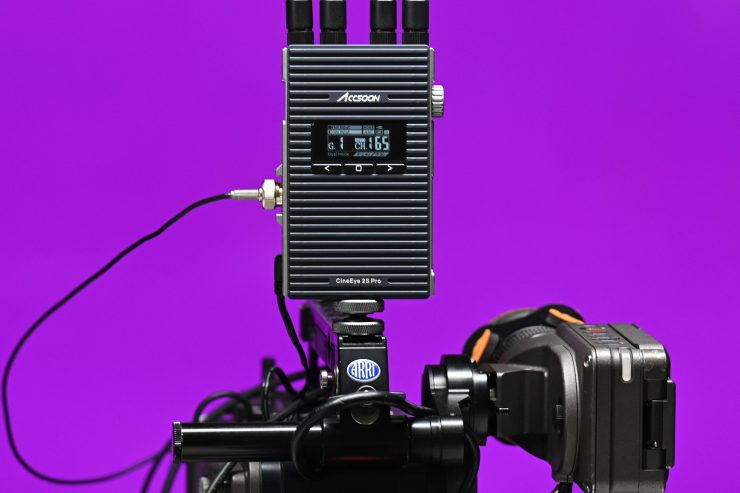
The new CineEye 2S Pro TX has an HDMI input (full-sized) and an SDI input, and the RX unit has an HDMI out and an SDI out. The big disadvantage the CineEye 2S Pro has when compared to the CineEye 2S Pro, is that it doesn’t have the ability to loop a signal through which is important if you are also running a monitor, monitor/recorder, or an EVF. This is something you need to be aware of.
How is it powered?
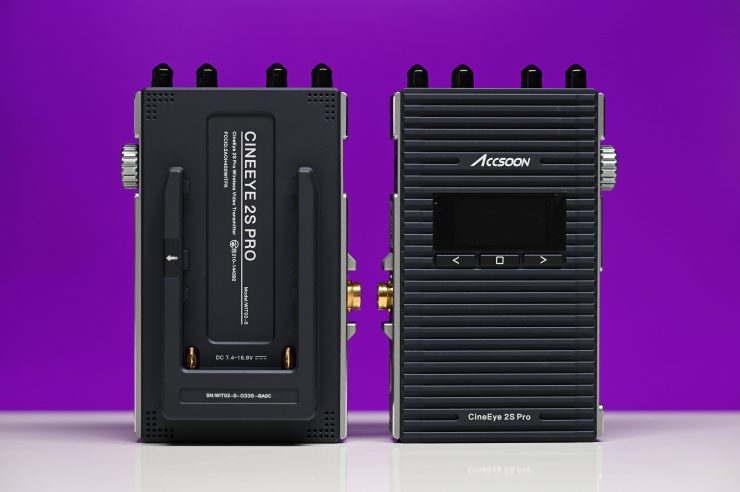
The CineEye 2S Pro needs to be powered via a single Sony NP battery. According to the company, a Sony NP-F970 battery can power the unit for up to 14 hours. I found the battery performance to be good.
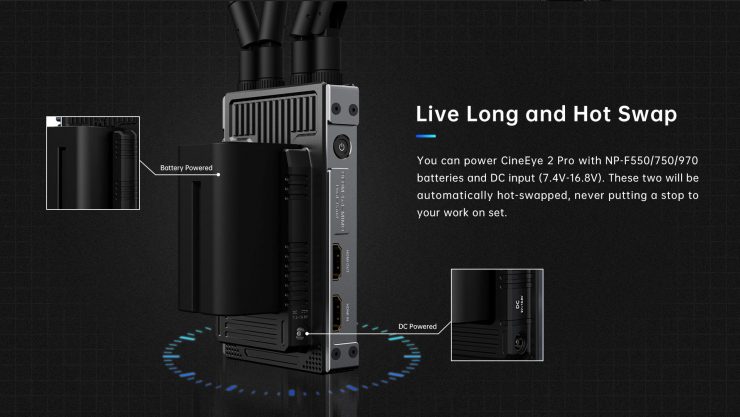
You can also choose to power the unit through the DC input (7.4V-16.8V) if need be. If you are inputting a 7.4V to 16.8V DC signal you can also run a battery and then hot swap that battery without the unit turning off.
iOS & Android App
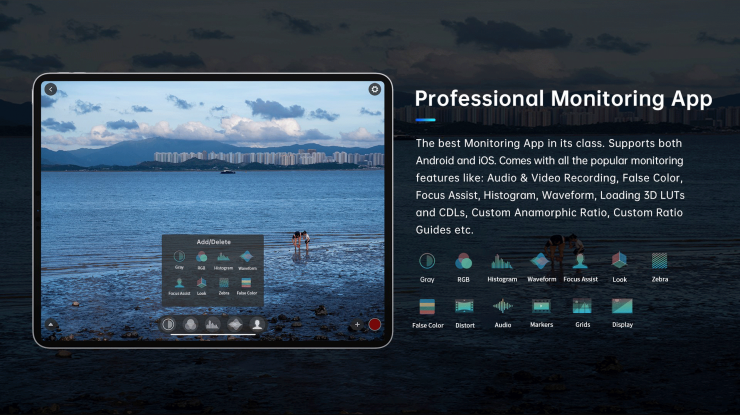
If you are streaming to an iOS or Android device, you can use the Accsoon App to monitor your wireless stream. The App features a lot of functionality and monitoring tools such as focus assist, waveform, false color, zebras, in-app audio and video recording, as well as the ability to load up your own 3D LUTs.
It is fairly easy to set up and get the app running. You just launch the app, turn on the TX unit (making sure it is receiving a signal from the camera) and join the CineEye2SPro Wi-Fi network.
More on how it actually performs later on in the review.
Camera Control (not currently supported)
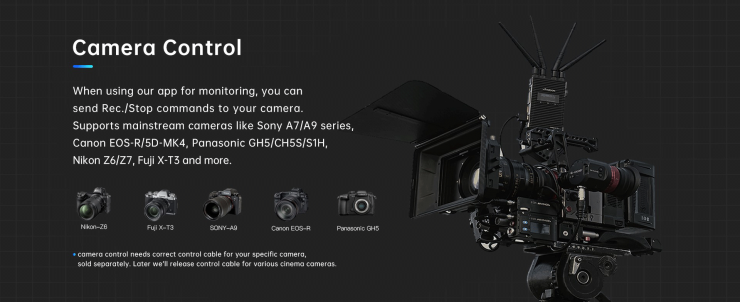
If you are using the Accsoon App for iOS or Android you will eventually be able to control the start/stop recording of certain cameras. According to Accsoon, the CineEye 2S Pro will work with the following cameras:
- Canon EOS R
- Fuji XT-3
- Canon EOS 5D Mark IV
- Sony a9
- Panasonic GH5/GH5S
- Panasonic S1H
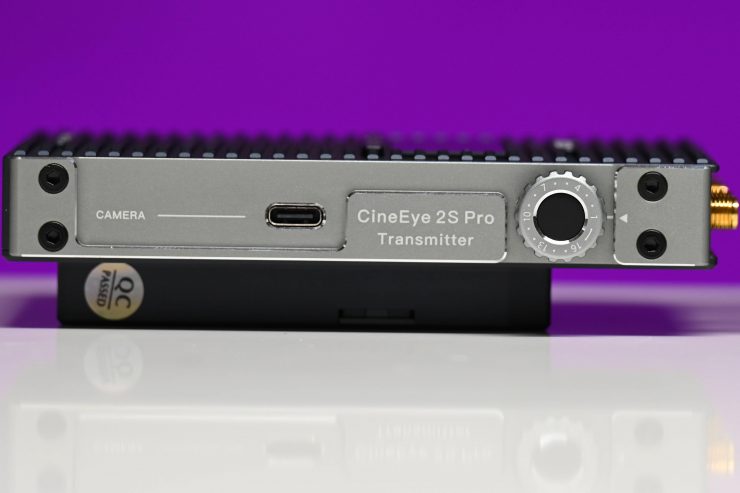
This is currently not available due to the global shortage of integrated chips.
Mounting Points
Accsoon only gives you a single 1/4 20″ mounting hole on both the TX and RX units. This is located on the bottom of the TX and RX units.
The system comes with two cold shoe to 1/4 20″ mounts. These are ok, however, because there is only a single mounting hole on the bottom of the TX and RX you end up having a system that is standing up very high on top of your camera.
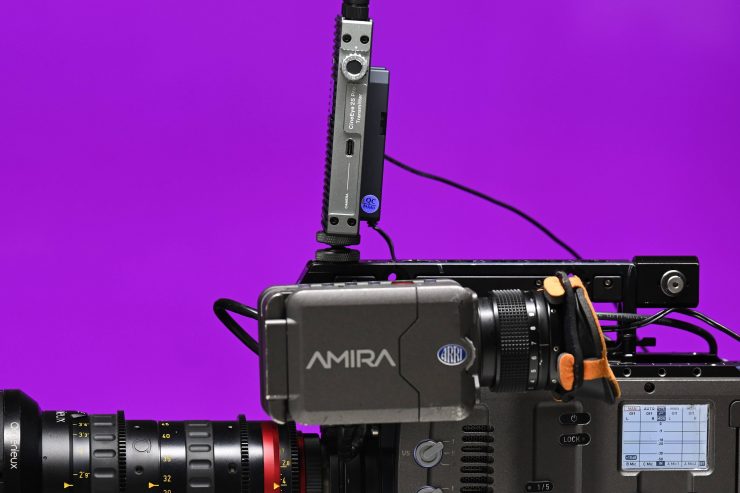
Above you can see what I mean.
If you want to mount the TX or RX units in another position you would have to use a monitor arm or something similar.
Having large wireless units with only a single mounting point is far from ideal.
Accsoon Go App Usability
The app features some nice functionality, however, like most app-based monitoring systems, there is certainly a lot of room for improvement.
Here is what monitoring functions are available using the app:
- Gray
- RGB
- Histogram
- Waveform
- Focus Peaking
- Look
- Zebra
- False Color
- Markers
- Anamorphic de-squeeze
- Grids
- Display
- Audio
You can do pinch to zoom for focus magnification. While most of the monitoring features work ok I wish more companies (and this doesn’t just apply to Accsoon) would actually put range indicators on features such as the waveform, false color, and audio meters. Having these items marked would let you know what you are looking at.
There is also peaking and zebras but you can only change the intensity of the zebras. This can be done from 0%-100%. You can’t change the color or the intensity of the peaking, it is stuck on red.
UPDATE: The latest iOS App(1.5.0) that was just recently released has added marks on the waveform and audio levels. Additionally, the focus peaking color can now be changed on the menu, users can select Red, Green, Blue, and White.
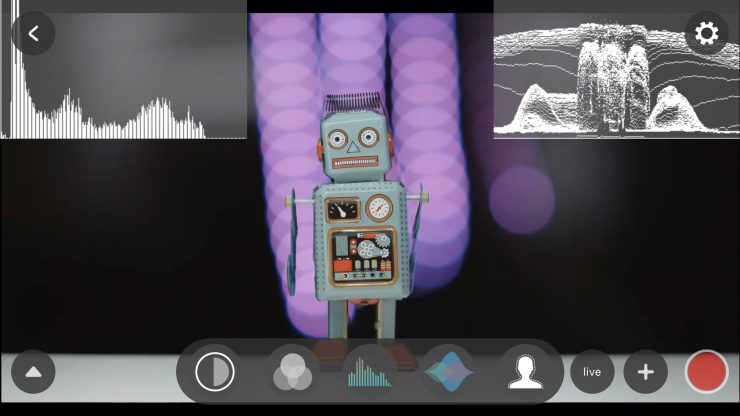
You can put multiple view assist tools up at the same time if you need to. Unfortunately, you can change the size or position of these monitoring assist tools.

By touching on the screen you can remove all of the overlays and just see a clean image.
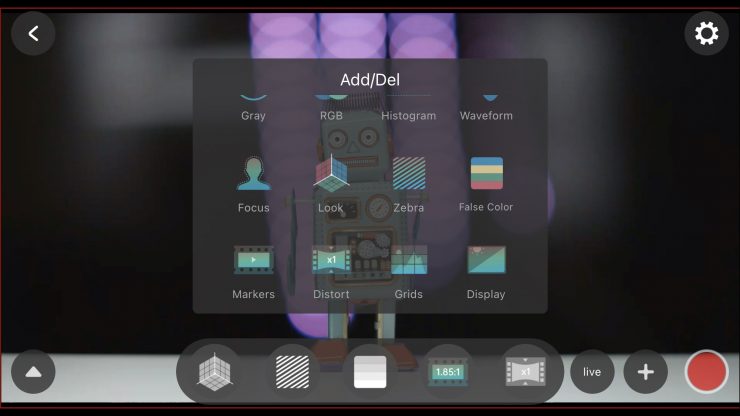
With the app, you can also choose to add or delete the various monitoring assist tools depending on what you need. I do find it a little strange that the Add/Del section actually names the icons, but on the main screen they aren’t named. This does make choosing some of them a little confusing.
I like that you can actually record the video you are seeing directly on the phone. The quality is ok and it allows you to view back clips and also to upload something to social media if need be.
The picture quality of the signal coming up on the app is pretty good. It will probably be good enough for most people who are buying a system such as this. In all honesty, it is one of the better-looking pictures I have seen from a wireless app-based system at this price.
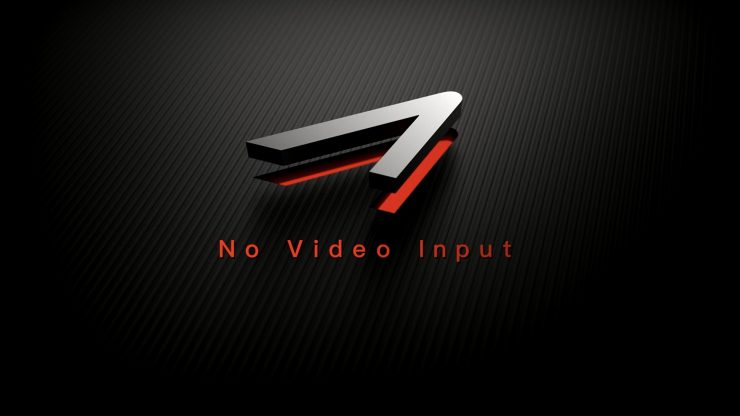
If you happen to lose the video signal while the app is open you will see the above warning on the screen.
What you need to clearly remember with wireless-based apps such as this is that if the power from the TX unit gets turned off you will need to re-establish the connection by choosing the Accsoon TX’s WiFi on your phone or tablet. This can be a pain for clients or producers who are viewing material on the mobile device and suddenly lose the picture.
With any app, there is always going to be the ability for improvement through updates. Unfortunately, Accsoon still hasn’t addressed some of the issues I have had with the app.
Broadcast to YouTube
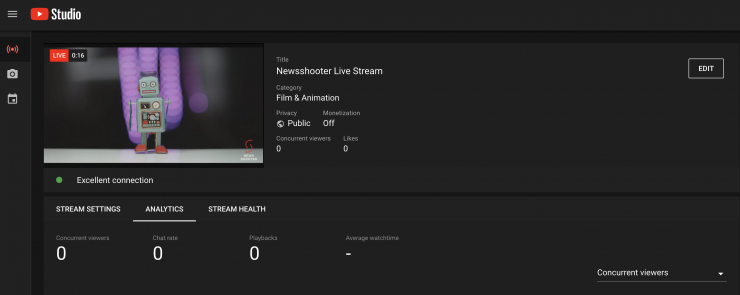
If you are using the Accsoon Go App you can directly stream live to YouTube by using your phone or tablet data connection.
This is actually super easy to do if you already have a YouTube account. All you need to do is to press the Live button on the Accsoon App and then enter the RMTP information that you can find on YouTube and press connect and it starts streaming straight away. Once it starts streaming you will see the word Living come up on the app.
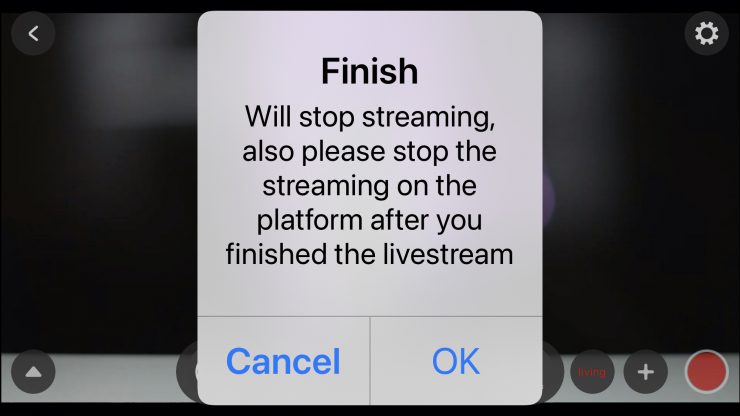
To end the stream you need to cancel it both on YouTube directly and on the Accsoon App.
This is a really handy little feature and it makes streaming to YouTube super easy and very affordable to do remotely. All the latest Accsoon CineEye models have the ability to be able to do this.
Image Delay
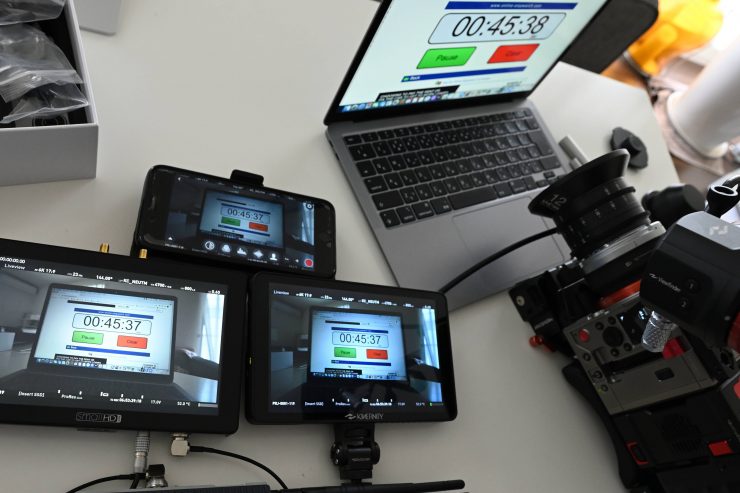
Image delay can be a problem with HDMI-based devices, but it really depends on the camera you are using. Some cameras have horrible image delay over HDMI, while others are really good. Now, the CineEyes 2S Pro has SDI as well, so in theory, you would assume the latency is going to be better. What you clearly need to remember is this is not a wireless video system that is capable of sending uncompressed, zero-latency images.
Accsoon claims their system has under 60ms of latency, but they don’t specify anywhere whether that is when using HDMI or SDI. So let’s do some tests and find out.
SDI
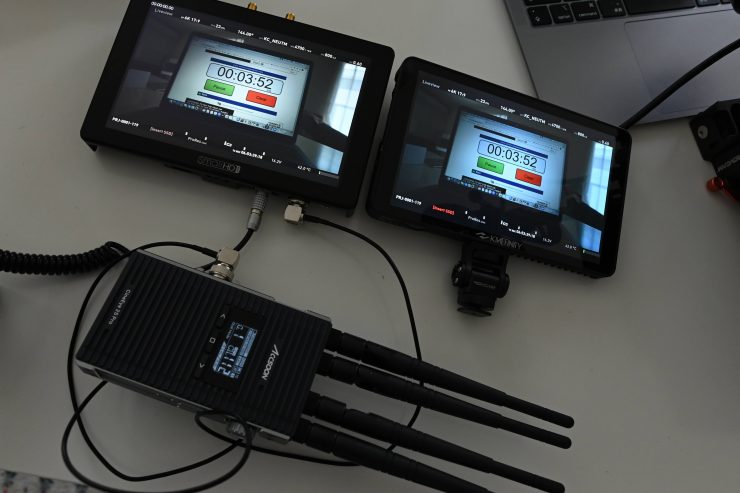
Ok, so let’s try using SDI first. I measured the delay average over a series of three tests at 77ms when viewing images on a monitor connected to the RX when the TX was set to High-Quality transmission. When I switched the TX to Speed I got a delay average over a series of three tests of 53ms. These results were pretty good for an affordable wireless video system. I found the delay difference between Speed and the High-Quality transmission setting to be negligible.
What do these figures actually mean? Well, anything below 100ms is considered to be low, because most humans don’t perceive a delay that small. Once you get over 100ms we perceive a noticeable delay.
So what about if you use the Accsoon Go app? I measured the delay average over a series of three tests at 53ms with the TX set to Normal transmission. When I switched the TX transmission to Speed I got a delay average over a series of three tests of 35ms. These results surprised me because the latency was actually less when using the app than it was if you used the TX and RX units together.
Above you can see what the delay looks like when you use the Normal Mode. This is the default mode when choosing the Data Rate Setting. You can see the delay from the camera screen, to the monitor connected to the RX, to what is being seen on the App.
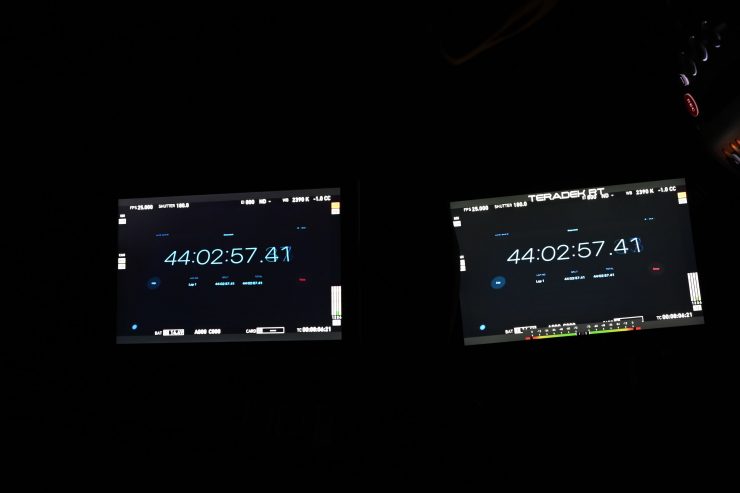
As a reference, above you can see that there is zero latency when using an expensive Teradek system (well, as close to zero as you can get. No wireless system is really zero in the scientific sense). This is a prime example of why you pay more money for a high-end wireless video system.
HDMI
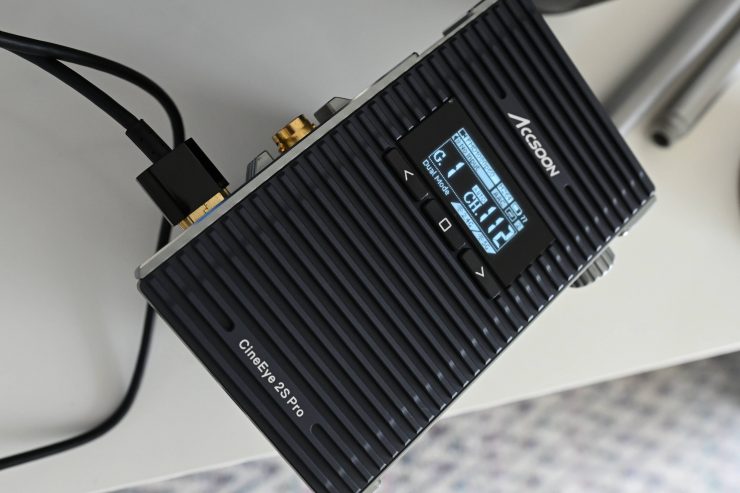
So what is the delay like if we use a camera that very little HDMI latency such as the Kinefinity MAVO LF? I measured the latency over a series of 3 tests when viewing images on a monitor connected to the RX unit when the TX set to Normal transmission at 46ms.
I then measured the delay average over a series of three tests at 54ms when using the Accsoon Go app with the TX set to Normal transmission. These results were excellent for a budget wireless video system. It was nice to see that the latency on the Accsoon App and the monitor that was connected to the RX unit were very, very close.
What you clearly need to remember about any camera that uses HDMI is that the image delay will vary dramatically depending on what camera you are using.
Thoughts on image delay
Even when using SDI you are not going to get the same sort of results as you will with an uncompressed, zero-latency system. At the end of the day, there needs to be an acceptable limit that you are willing to tolerate. I think when using an app people can forgive higher latency, but if you are using dedicated TX and RX units it really needs to be below 100ms. When I say below 100ms, that is for ‘affordable’ budget systems. For high-end systems, it should be almost zero.
In saying all of that, I was impressed with the low latency of the Accsoon CineEye 2S Pro system. Regardless of whether you are using SDI, HDMI, or the Accsoon App, the image delay is more than acceptable. Could you use it to pull focus remotely? Possibly, but if that is your main intent you would still be better off with a zero-latency uncompressed system.
For the price of this system and its capabilities the image delay is impressive.
Delay on other app-based systems
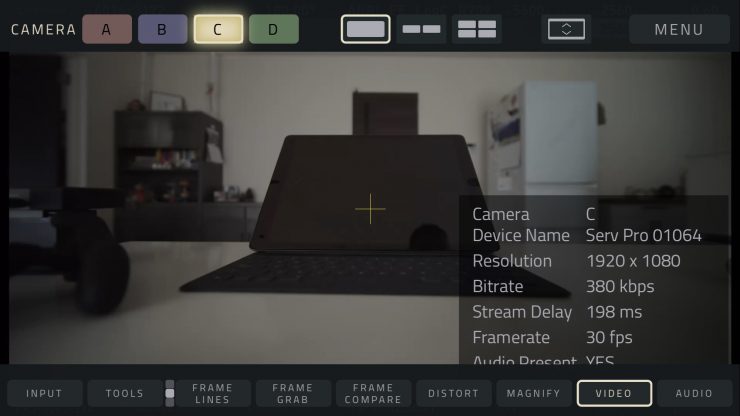
If we are just looking at the app-based latency, we need to look at how other wireless systems that can stream to an app perform. Even a device like the Teradek SERV Pro has a very noticeable delay. I did a quick test and found that I was seeing a latency delay of around 200ms. This same delay was there regardless of what camera I used or whether I was feeding an SDI or HDMI signal.
As a more realistic comparison, the latency from the original Accsoon CineEye Wireless Video Transmitter was 203ms which was far worse than you get CineEye 2S Pro.
Real-world performance
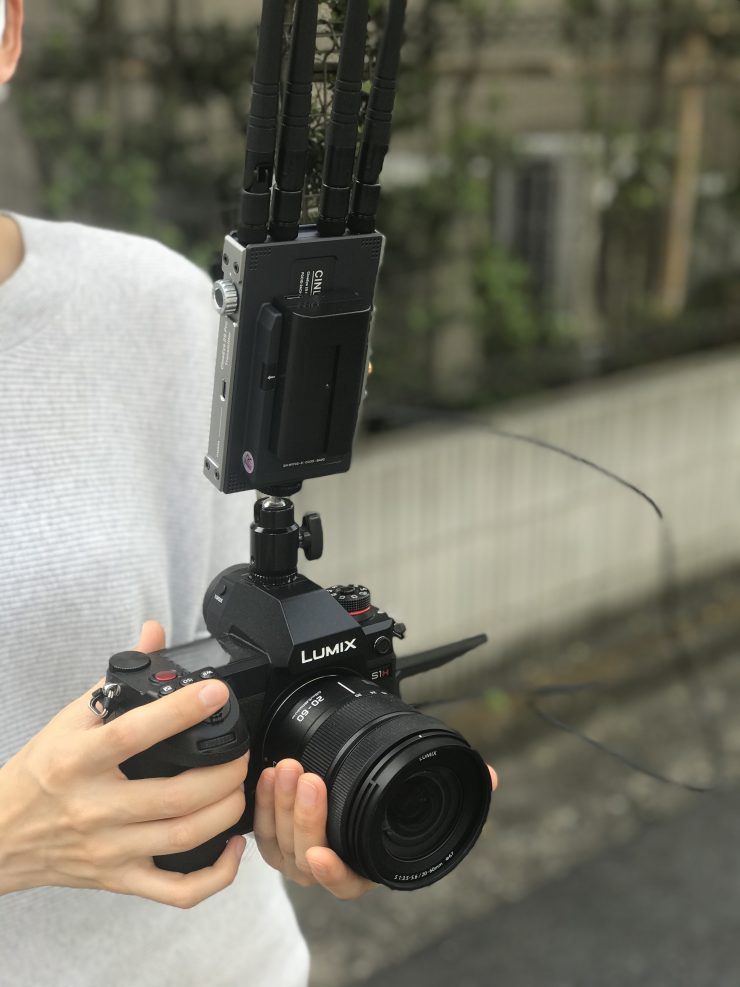
How does the CineEyes 2S Pro actually perform in the real world?
The real transmission distance is also relevant to the current air electromagnetic environment, because the system works in the ISM band, and therefore has exposure to all kinds of 5GHz band air interference.
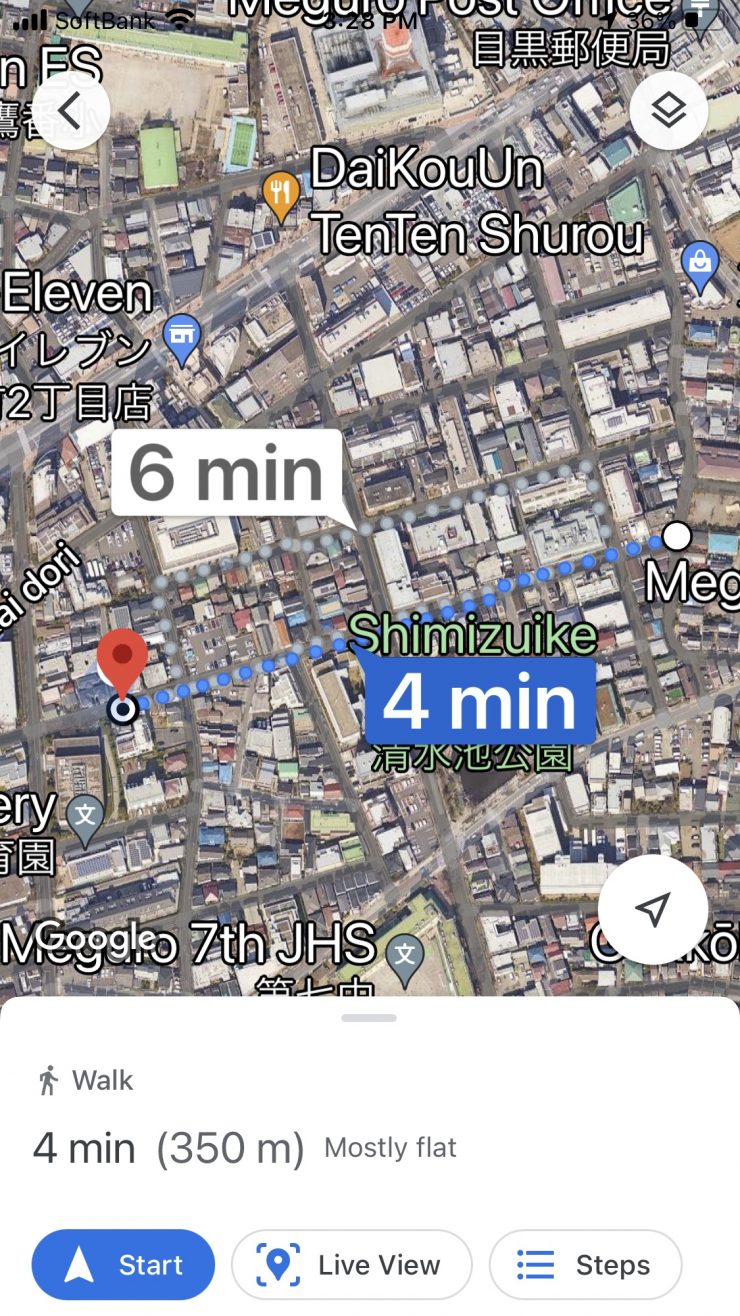
With this in mind, I decided to test the range and performance of the system. To test the range of the system I remained in line of sight of the receiver and started walking away with the TX attached to the camera. I found that I could easily get 350m (1148′) and still have a stable signal. I’m sure I could have gotten even more distance, but I ran out of straight road where I was doing the test. Yes, if something gets in between the RX and the TX you will get breakup and you can lose the signal. The nice thing is if you do lose the signal it comes back once you are back in range without you having to do anything.
Now, Accsoon claims a maximum operating range of 1200 feet (365m) line-of-site, but this is usually only going to be achievable on flat, open terrain where there is little wireless interference. I did this test in the middle of Tokyo which is one of the most heavily congested RF and WiFi traffic areas on the planet. It was interesting to see that the CineEyes 2S Pro was able to reach its claimed operating distance in this environment.
In fact, the CineEyes 2S Pro matched the Vaxis Atom 500 (which I have previously reviewed) in terms of stable signal range. Both systems exceeded every other wireless video system I have ever tested in range, regardless of price or claimed range. What you should clearly remember is that the distance you can achieve will vary greatly depending on where you are and how you are using the system.
What was equally amazing was I could receive a signal using the app on my iPhone at the same distance as the receiver. Usually, most app-based transmissions have a very limited range. Now, the signal when using the app does break up every now and then, but it always managed to re-establish the signal without me needing to do anything.
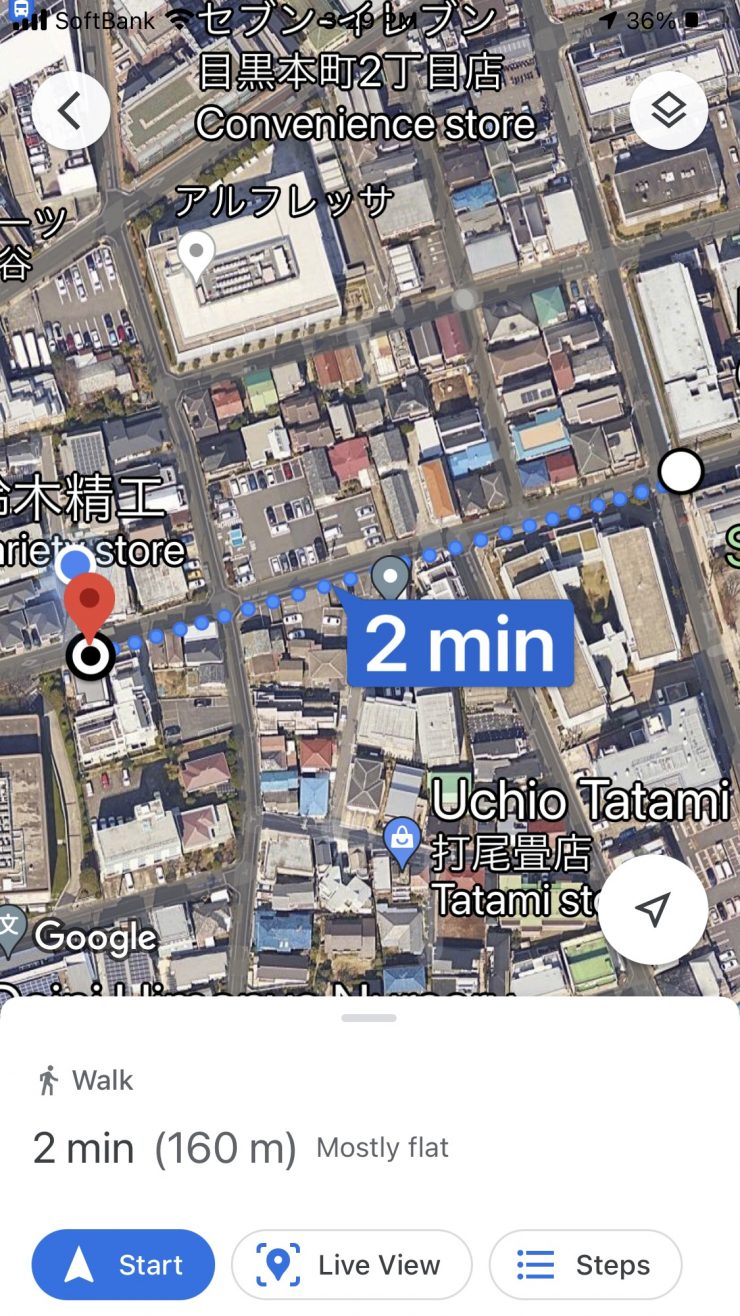
However, from my testing, I think the actual stable range when using the Accsoon App is closer to around 160m, but as I mentioned it will work out to over 300m.
The dual-band transmission technology really works well and the CineEyes 2S Pro is a great option if you need multiple people to monitor video using smartphones or tablets over distances.
To show just how impressive the Accsoon’s range is when using the app, have a look below at the distance obtainable with the Vaxis Atom 500 and the original Accsoon CineEye.
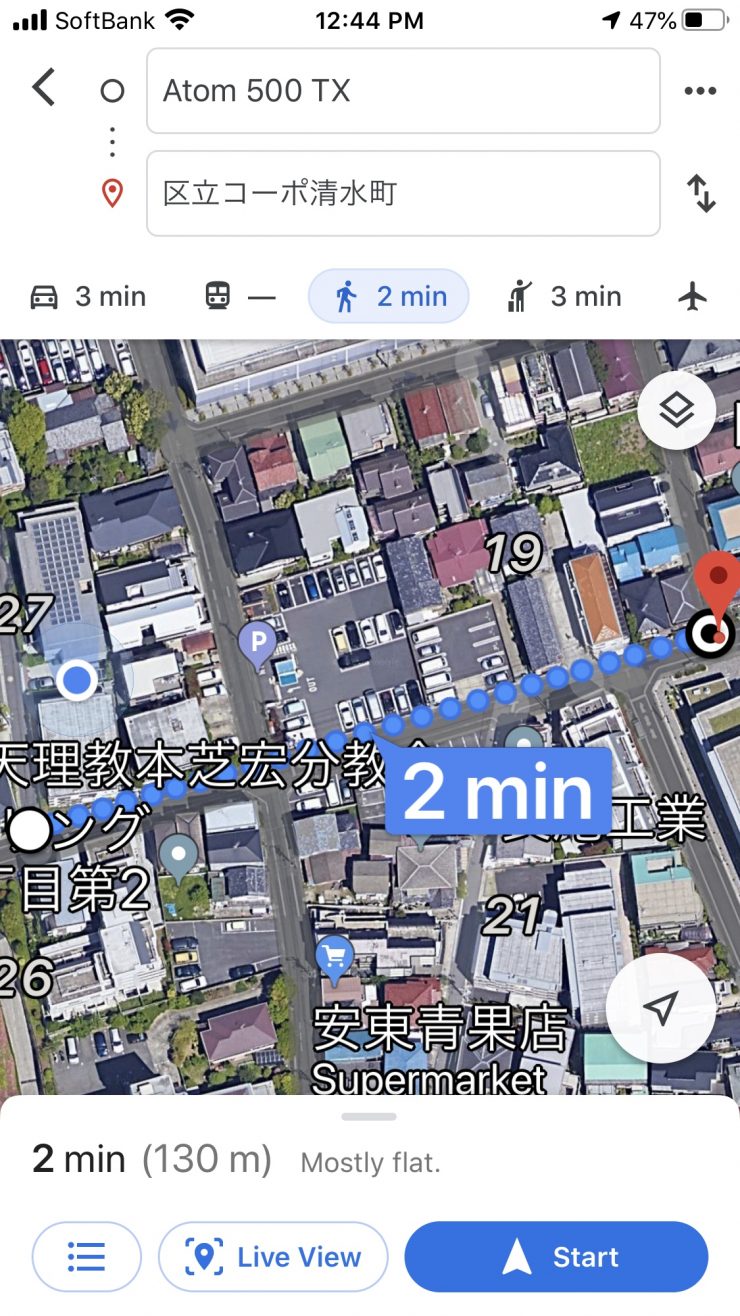
When I was using the Vaxis Atom 500 with the Vaxis Vision App I found I could get around 130m (426′) maximum distance. In saying that, the app signal is never really that stable once you start getting around 10-15m away from the TX. I was constantly seeing the picture disappear and then reappear.
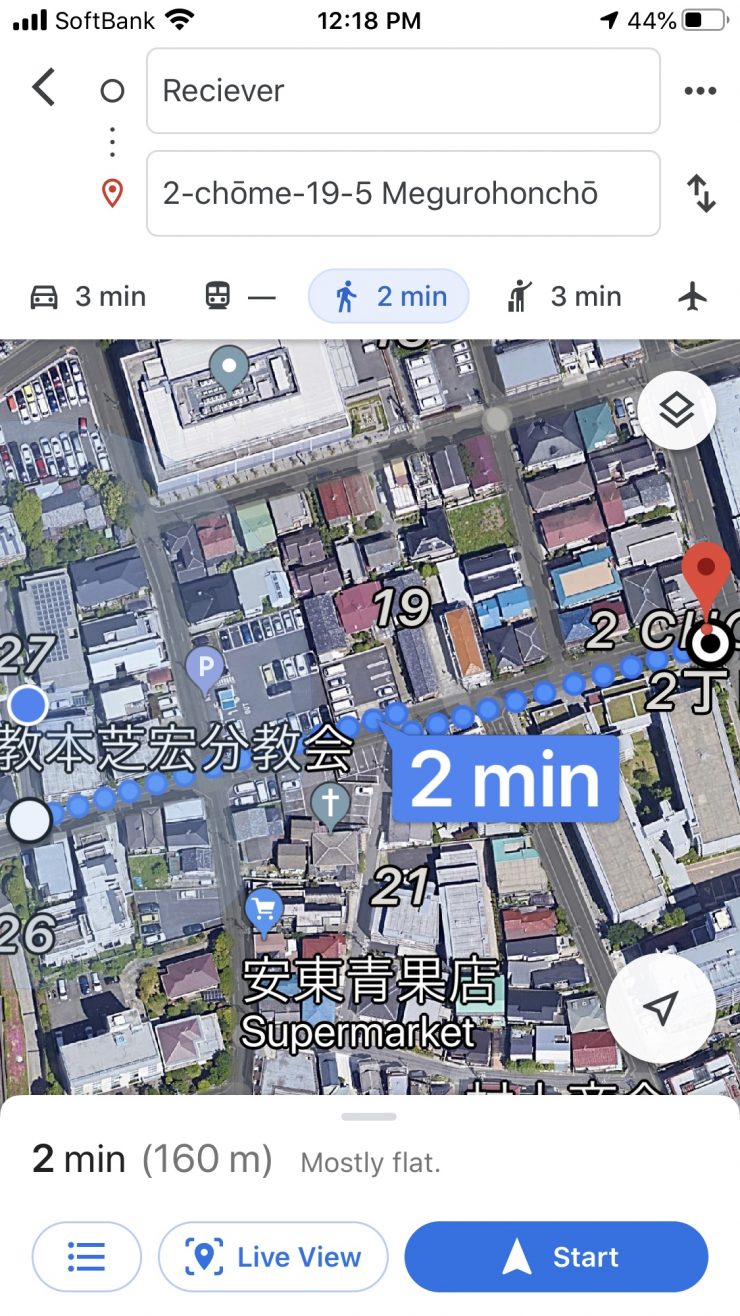
As a comparison, I also did a distance test with the original Accsoon CineEye system. I found I could get around 160m before the signal dropped out.
I also wanted to see what would happen if the system lost connection, so I turned the receiver off and then back on again. This would be common practice if you were swapping over a battery. It took around 23 seconds for the receiver to re-establish a connection which while not fast, was still ok.
Next, I turned the transmitter off, which is more commonly what may happen when you change over a camera battery or power the camera off and then on again. This time it took around 35 seconds to get a picture back up on the monitor that was connected to the RX unit.
What about if I pulled out the SDI cable from the camera? This time the system re-established connection in just two seconds.
So what would happen if I suddenly changed the frame rate to 50p on my camera while the system was on? Well, it didn’t work, because this system won’t accept a 422 3G SDI signal. With my ARRI Amira, I could only feed it a 422 1.5G signal. Ok, so what about if I changed the frame rate from say 23.98p to 25p? It only took around 5 seconds for the signal to come back. UPDATE: The CineEye 2S Pro does support 422 3G SDI but can only accept a Level A input, I had my Amira on Level B.
The system is pretty straight forward and easy to use and it connects back up reasonably quickly without any issues. This means it passes my wireless frustration test.
Whenever I review wireless video transmitters I do the test in the exact same place under the same operating conditions. This way I get a good idea of how various competing systems compare.
The range of the Accsoon CineEye 2S Pro was very impressive and it has by far the best range if you are using an app to monitor images.
Price & Availability
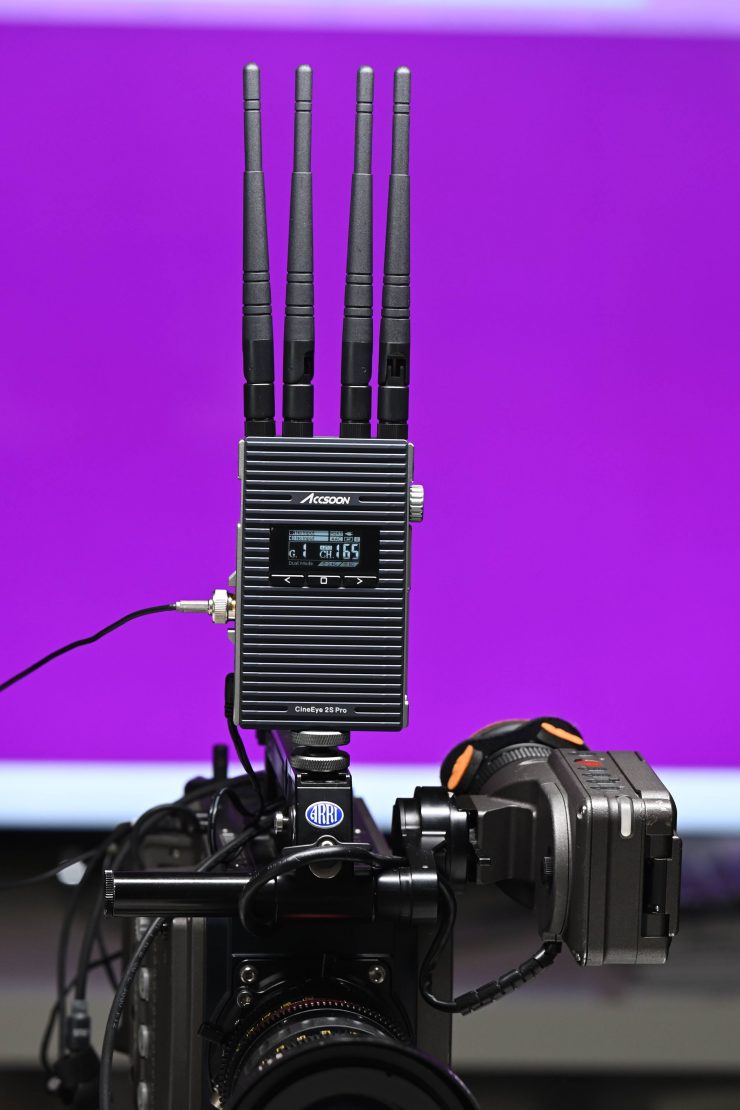
The Accsoon CineEye 2 Pro retails for $649 USD and it is now available to pre-order. This makes it just $50 USD more than the HDMI only CineEye 2 Pro.
How does this price compare to other wireless video systems with SDI that can also stream to an app?
Please note all of the above systems offer different features and functionality.
Competition
There are a few products out there that are in direct competition with the Accsoon CineEyes 2S Pro.
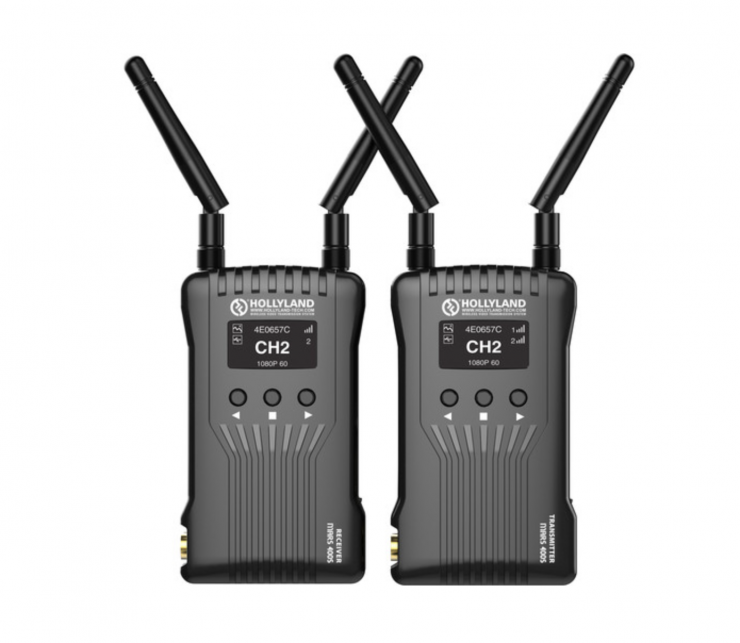
Hollyland has the Mars 400S The MARS 400S is SDI and HDMI compatible and it has an operating range of up to 400ft range.
The MARS 400S can be used with an iOS and Android APP. With an app you can stream video that can be watched on up to four iOS or Android devices at once. The receiver can also be used at the same time. The MARS 400 retails for $549 USD.
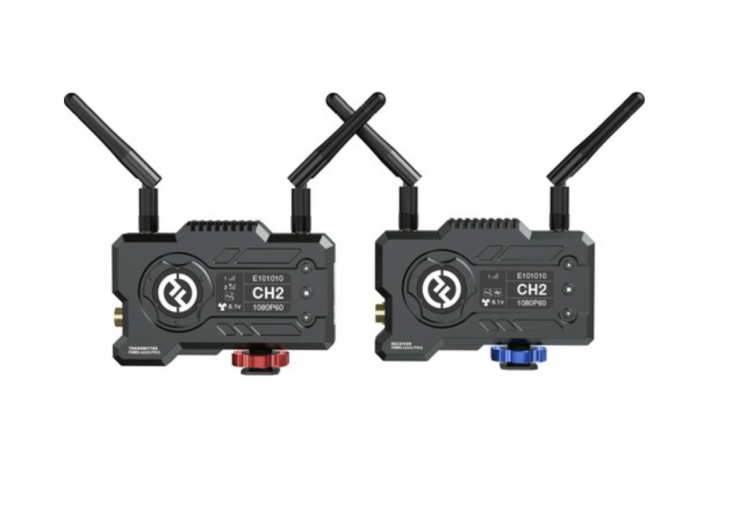
Hollyland also has the Mars 400S Pro. This system has HDMI and SDI inputs on the transmitter, and the receiver offers SDI and HDMI outputs. It features a claimed low 0.08s latency with line-of-sight transmission up to 400′ to the receiver and up to 300′ to the Hollyview Wi-Fi app.
Using the Hollyview app for iOS or Android, you can monitor your video transmission in real-time via a Wi-Fi connection as well as live stream directly from the receiver via your computer using a USB Type-C adapter.
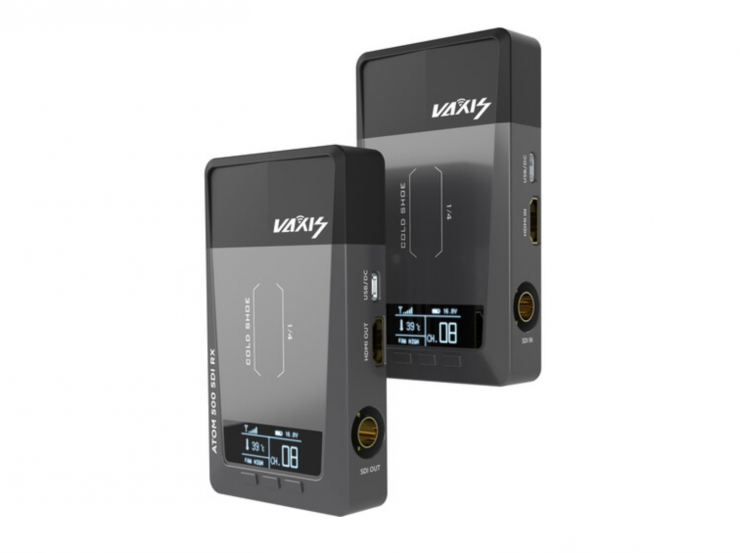
Vaxis sells the ATOM 500 SDI. The transmitter features one 3G-SDI and one HDMI input while the receiver has one 3G-SDI and one HDMI output. The ATOM 500 SDI is claimed to be able to transmit visually lossless, H.265 video signals to the Vaxis receiver with less than 80 ms latency. The system has a range of up to 500′ (line-of-sight) and it can also multicast via Wi-Fi to up to three mobile devices for monitoring.
They can be powered using its USB Type-C connector with the included cable or by using a separately available L-series battery. The USB input can also be used to upgrade the firmware.
Conclusion
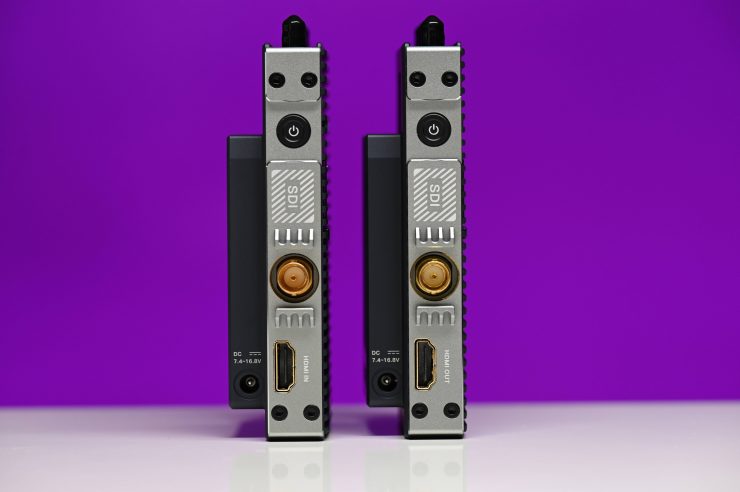
A wireless video transmission system needs to have rock-solid reliability. It also has to not get in your way and be easy to set up and use. Look, I get it, this is a cost-effective wireless system, it is not supposed to perform like a dedicated high-end professional wireless system. In saying that, it still needs to be reliable and easy to use.
TheAccsoon CineEye 2S Pro is well built, easy to set up and use, and has a great operating range. The app is reasonably good but there is certainly room for improvement. The boot-up time is a bit slow and you need to be aware of that. However, in saying that, most wireless systems don’t have particularly fast start-up times.
As far as image delay goes it is pretty good. You need to clearly know that this system is not going to provide you with latency-free images. The results you are going to get will depend greatly on the camera you are using and whether you are using HDMI or SDI.
In saying all of this, if you are talking about any app-based wireless streaming, they are all are going to have some sort of image delay. However, the Accsoon has the lowest latency of any of these types of systems I have tested.
I like what Accsoon has done, and the CineEye 2S Pro features a lot of functionality and performance for the price. The image delay is minimal, the quality of the image on the app is good, and the ability to stream directly to YouTube is a nice additional feature. It does, however, face stiff competition from systems produced by both Hollyland and Vaxis.
Like what we do and want to support Newsshooter? Consider becoming a Patreon supporter and help us to continue being the best source of news and reviews for professional tools for the independent filmmaker.

